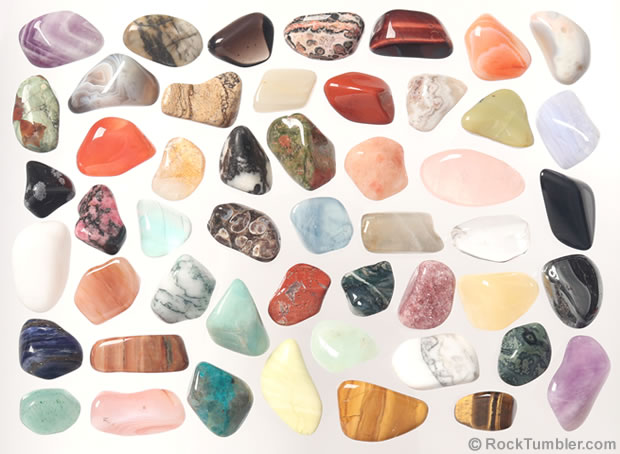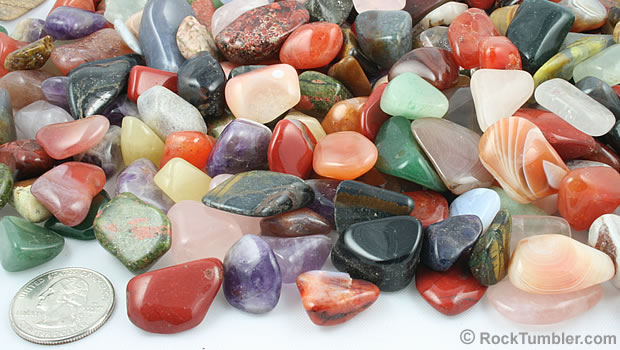Home » Tumbled Stones » Single-Variety
| Warning: Polished stones can be a choking hazard for small children |
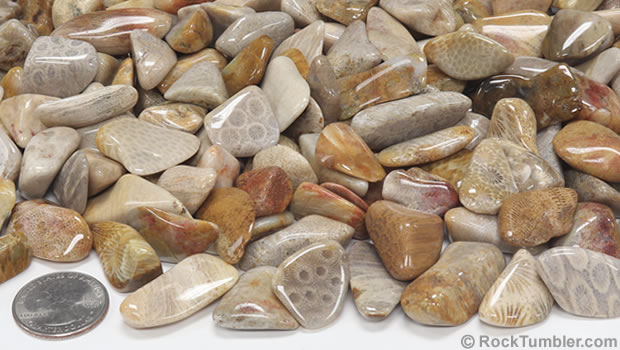

Agatized Coral Properties | |
| What is Agatized Coral? | Coral is an organism that lives in warm, shallow parts of the ocean. It builds a calcareous "skeleton" that is often preserved as a fossil. Sometimes the calcareous skeleton is replaced with a microcrystalline quartz known as "agate". When this occurs, the material is known as "agatized coral" or "agatized fossil coral" or "silicified coral". If you look closely at the photo, you might be able to recognize coral structures in some of the pieces. |
| Color | The tumbled coral that we are selling here is mostly gray or yellowish brown. A rare few pieces are reddish brown. |
| Clarity | Opaque to slightly translucent. |
| Uses | Agatized coral is an interesting material for wire-wrap, tumbled stone jewelry, craft and decor projects. |
| Weight | About 75 to 100 stones per pound. |
| Other Information | The agatized coral being sold here is very well silicified (agatized). Many pieces clearly display coral structures. These pieces exhibit patterns which can resemble honeycomb, plant cells, or fossilized wood. These represent different types of corals and coral fragments broken at various angles. When searching for these patterns, look at all sides of a piece and imagine the different angles in which brittle coral structures might be broken. |
| Locality | Indonesia. |
| Treatments | None known. |
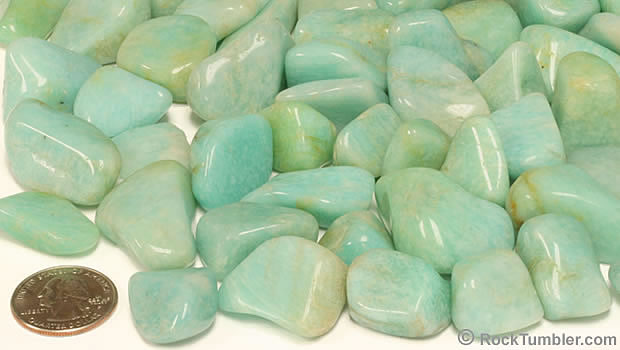

Amazonite Properties | |
| What is Amazonite? | Amazonite is a green microcline feldspar that is exceptionally popular as a gemstone. It was named for the Amazon River which flows near some of the first large commercial deposits in Brazil. It is a favorite of rockhounds, mineral collectors, and many artistic jewelers. |
| Color | Light green to bright green, or bluish green. Most of these stones exhibit rust-colored staining along fractures. |
| Clarity | Translucent. |
| Uses | Amazonite is great for a variety of gemstone, craft, jewelry and decorative projects. |
| Weight | About 30 to 50 stones per pound. |
| Other Information | Amazonite is a mineral that cleaves at right angles. That causes its tumbled stones to be somewhat "blocky" in shape. |
| Locality | Mozambique (a country on the southwest coast of Africa). |
| Treatments | None known. |
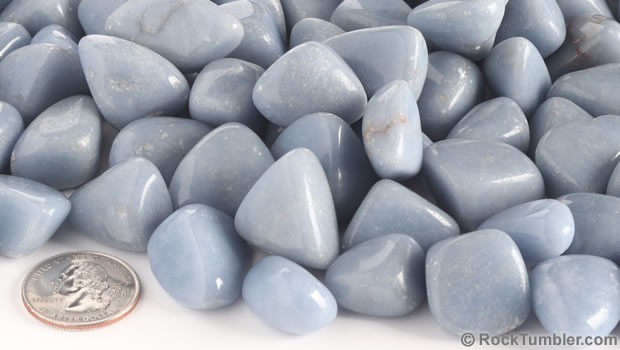

Angelite Properties | |
| What is Angelite? | "Angelite" is a marketing name for a rock composed almost entirely of a mineral named "anhydrite". Most of the anhydrite found throughout the world has a brown to gray to white color. However, in a few locations, most notably at a few sites in Peru, anhydrite can be found with a slightly bluish gray to grayish blue color. These specimens of blue anhydrite are known in the lapidary trade as "angelite". Some people report that angelite forms from celestite. That is incorrect. Celestite is a strontium sulfate, while angelite is a calcium sulfate. |
| Color | Slightly bluish gray to grayish blue, often with a bit of brownish or grayish matrix. |
| Clarity | Translucent to opaque. |
| Uses | When of fine color, angelite can be used to make beautiful blue beads, cabochons, and other objects. It is often used to make tumbled stones and carved into small sculptures. Be careful with angelite, because it has a Mohs hardness of only 3 to 3.5. That makes it very soft and easily scratched. Brushing against many common objects can put an unsightly gouge in angelite. If you have a nice angelite item, protect it from abrasion and impact. Angelite is not suitable as a ring stone. |
| Weight | About 30 to 50 stones per pound. |
| Other Information | These stones are much larger than other stones sold on this page of our website. Note how their size compares to the quarter in the photo. |
| Locality | Much angelite is found in Peru. However, we are not certain of the location where the stones sold here were found. |
| Treatments | None known. |

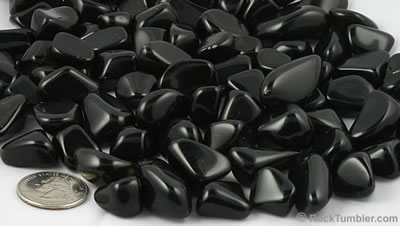
Apache Tears Properties | |
| What are Apache Tears? | Apache Tears are round nodules of an igneous rock known as "obsidian" that can be polished to a beautiful jet-black luster. If you hold them up to the light, you can see that they are a translucent to sometimes transparent "glass" created in nature by a volcanic eruption. Tiny amounts of volcanic ash are embedded within the glass. |
| Color | Black! |
| Clarity | Translucent to transparent. |
| Uses | We think that Apache Tears make great pendants; add a gemmy appearance to a potted plant or planter; and, using a bell cap and chain, they are a great stone to dangle in front of a sunny window. |
| Weight | About 75 to 110 stones per pound. |
| Other Information | The name "Apache Tears" is from a Native American legend of Arizona. During a battle between Apaches and the US Cavalry in 1870, the outnumbered Apaches, facing defeat, rode their horses over a cliff rather than allow themselves to be killed by their enemy. Their families cried when they received the sad news, and their tears turned to stone as they hit the ground. We know of people who enjoy giving these stones to others and sharing the story of Apache Tears. |
| Locality | Arizona, USA. |
| Treatments | None known. |
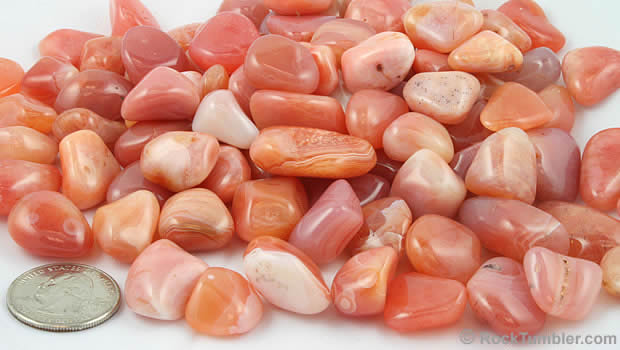

Apricot Agate Properties | |
| What is Apricot Agate? | Apricot Agate is a name used for agate nodules and nodule pieces with yummy pinkish orange, pastel orange or slightly yellowish orange colors. These remind some people of apricot fruits. The material is often marked with white to cream-colored banding. |
| Color | A blend of white, yellow, pink, peach and orange agate. |
| Clarity | Translucent. |
| Uses | A colorful stone with character that works great in many gemstone, craft, decor and jewelry projects. |
| Weight | About 75 to 110 stones per pound. |
| Other Information | Apricot agate forms as small nodules, usually in igneous rocks. They are almost always banded and sometimes have a center of crystalline quartz. The stones we sell here are small nodules and nodule fragments that have been tumbled to a round, smooth finish. |
| Locality | Botswana (a country in southern Africa). |
| Treatments | None known. |

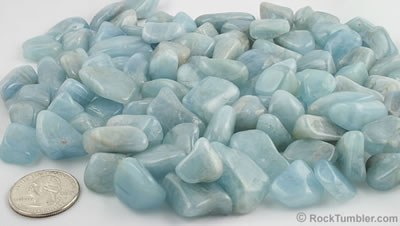
Aquamarine (Blue Beryl) Properties | |
| What is Blue Beryl? | Beryl is a silicate mineral that contains small amounts of beryllium. It occurs in a variety of colors, and gem-quality beryl is named according to its color. Bright green is known as "emerald," blue (like this material here) is known as "aquamarine," yellow and yellowish green are known as "heliodor," and pink is known as "morganite." Some beryl is colorless and is known as "goshenite." So, is this material really aquamarine? We sent one of these stones to the Gemological Institute of America's laboratory and asked them to identify it. They identified it as aquamarine. You can see the report here. |
| Color | Light to medium blue. |
| Clarity | Translucent to semitranslucent to opaque. |
| Uses | Beautiful Aquamarine like this is great for a variety of gemstone, craft, jewelry and decorative projects. There are very few light blue gemstones, and that is part of what makes this material desirable. It makes great pendants, wire-wrapping stones, accents in retail displays, and can be used in a variety of art projects. And, a handful of aquamarine in a small brown wooden bowl will look spectacular on your desk or table. |
| Weight | About 75 to 110 stones per pound. |
| Treatments | The color of beryl is often modified by heating or irradiation. We have no information that indicates that this aquamarine has been treated. |
| Locality | Angola |
| Treatments | None known. |
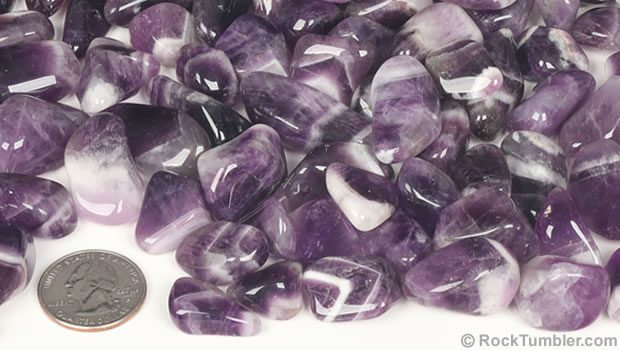

Banded Amethyst Properties | |
| What is Banded Amethyst? | Amethyst is a purple variety of crystalline quartz. It is the world's most popular purple gemstone and has been used for thousands of years. This amethyst is tumbled from crystals that grew with zones of white quartz alternating with purple amethyst. That is the cause of the banded pattern. Some people call it "chevron amethyst" because some pieces have a "V" shaped color pattern in the shape of a chevron. |
| Color | Light to deep purple amethyst with white quartz bands making a strong contrast. |
| Clarity | Transparent to translucent. |
| Uses | Banded amethyst makes especially nice pendants and wire-wrapped items. It is popular in a wide range of gemstone, jewelry, craft and decorative projects. |
| Weight | About 75 to 110 stones per pound. |
| Other Information | Amethyst is a February birthstone, the 17th anniversary gemstone, and the Pisces zodiac gemstone. Trivia: Amethyst is one of the precious stones referred to in the Bible. |
| Locality | Namibia (a country on the west coast of Africa). |
| Treatments | None known. |
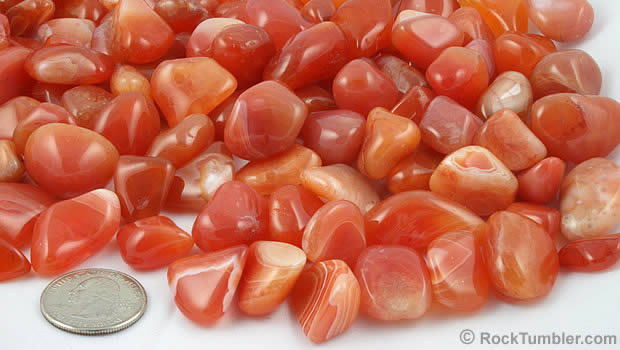

Banded Carnelian Properties | |
| What is Banded Carnelian? | Banded carnelian is an orange agate with white bands and patterns. It usually forms as nodules in igneous rocks. These nodules and partial nodules are tumbled smooth and polished to produce these pretty tumbled stones. |
| Color | Orange to orangish-red with white bands and patterns. |
| Clarity | Translucent. |
| Uses | Banded carnelian works great in a number of gemstone, craft, jewelry and decorative projects. It is a favorite wire-wrapping stone and a colorful accent stone for potted plants. |
| Weight | About 75 to 110 stones per pound. |
| Other Information | Agate is a microcrystalline form of quartz. Trivia: Carnelian is one of the precious stones referred to in the Bible. |
| Locality | Botswana (a country in southern Africa). |
| Treatments | None known for the material that we are selling, but sometimes carnelian agate is heated to improve its color. |

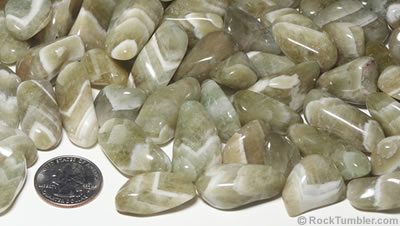
Banded Prasiolite Properties | |
| What is Banded Prasiolite? | "Prasiolite" is a marketing name for quartz that is yellowish green to green in color. Its color can be natural, but most often, prasiolite is produced by people who obtain lightly colored amethyst and heat or irradiate it until the purple color becomes green. The material that we are selling is prasiolite with bands of white quartz. That is where the name "banded prasiolite" is from. We believe that the green color in the stones sold here is a result of heat treatment. Some people call prasiolite "green amethyst". That name is a misnomer (an incorrect name). The Federal Trade Commission, in their Guides for the Jewelry, Precious Metals, and Pewter Industry says that the name "green amethyst" is incorrect, and that use of the name in commerce can be considered misleading, unfair or deceptive. In their guide they hold up "green amethyst" and "yellow emerald" - by name - as examples of misleading names. We do not call this material "green amethyst" because that name is incorrect. Learn more about prasiolite in an article that we published on Geology.com here. |
| Color | Yellowish green quartz with thin bands of white quartz. |
| Clarity | Translucent to opaque. |
| Uses | Prasiolite is used in all types of jewelry. It is cut as faceted stones, beads, and cabochons. It is also used to make tumbled stones and small ornamental objects. It has a Mohs hardness of 7 and is durable enough for use in most types of jewelry. |
| Weight | About 50 to 70 stones per pound. |
| Other Information | Prasiolite was not a well-known material in the 20th century. However, starting in about 2005, more and more of it has been entering the gem and jewelry industry of the United States. |
| Locality | Much prasiolite is produced from amethyst mined in the South American countries of Brazil, Bolivia, and Uruguay. It is also produced in other countries. Heat and irradiation treatment is sometimes done outside of the country where it was mined. We are not certain of the location where the stones being sold here were mined. |
| Treatments | We believe that the stones sold here have a green color that was produced by heating. |
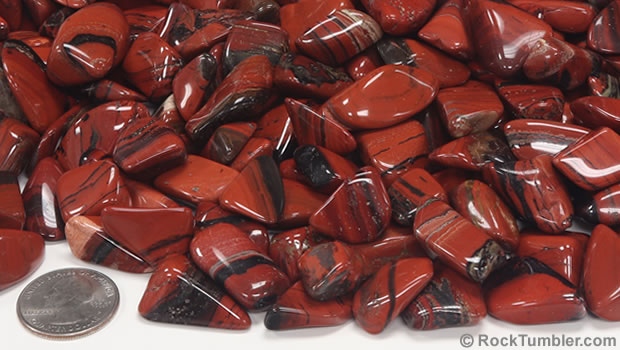

Banded Red Jasper Properties | |
| What is Banded Red Jasper? | The Banded Red Jasper (sometimes called "jasperite") being sold here consists of a red jasper that is marked with parallel black bands. The bands are composed of microscopic black mineral grains surrounded by red jasper or transparent quartz. The black minerals are likely particles of magnetite or hematite. Material like this is often associated with the Precambrian banded iron ores of the United States, South Africa, Australia, and other countries. |
| Color | A bright red matrix with thin black bands. |
| Clarity | Opaque. |
| Uses | Banded Red Jasper is a nice stone for use in a variety of gemstone, craft, jewelry, and decorative projects. |
| Weight | About 80 to 110 stones per pound. |
| Other Information | The black bands of some stones have a weakly magnetic property that can be detected by carefully moving a small magnet over them. The black mineral particles that make up the bands are likely particles of magnetite or magnetic hematite. |
| Locality | South Africa. |
| Treatments | None known. |
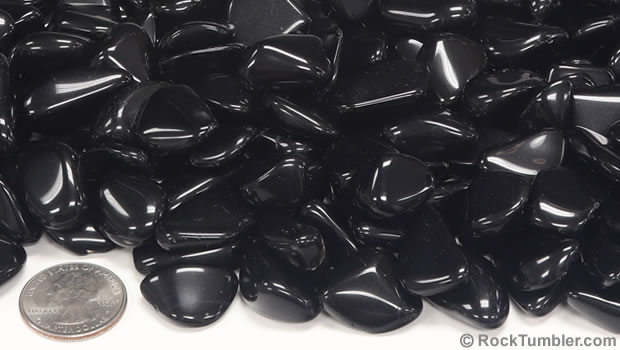

Black Obsidian Properties | |
| What is Black Obsidian? | Black obsidian is a volcanic glass. It is an igneous rock that forms in areas of recent volcanic activity, where molten rock material has cooled so rapidly that no mineral grains had time to form within it. |
| Color | Black. |
| Clarity | Semi-opaque to translucent. |
| Uses | Suitable for a wide variety of decor and craft projects. For jewelry, it is best used in pendants, brooches, and other items that will not be subjected to impact or abrasion. |
| Weight | About 90 to 120 stones per pound. |
| Other Information | Obsidian is a natural glass with a Mohs hardness of about 5.5, so it is fragile and easily scratched, chipped, or broken. |
| Locality | Unknown. |
| Treatments | None known. |
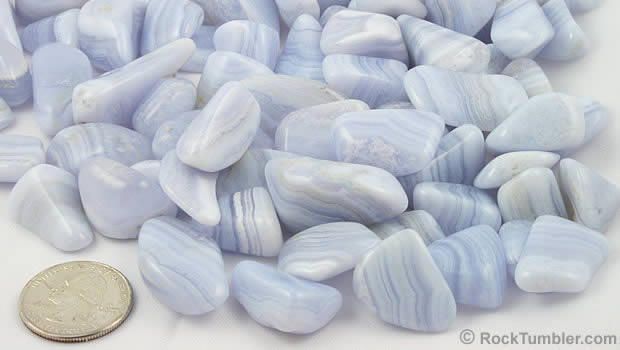

Blue Lace Agate Properties | |
| What is Blue Lace Agate? | Blue Lace Agate is a beautiful pale blue chalcedony with thin, delicate bands. The bands have complex curves and patterns that resemble a lace-embroidered fabric - thus the name "Blue Lace." |
| Color | Translucent blue chalcedony with white bands, sometimes separated by bands of transparent or druzy agate. |
| Clarity | Alternating bands of transparent to translucent agate. |
| Uses | Blue Lace Agate is a popular jewelry stone. A nice tapered piece would make a stunning pendant to wear over a dark blouse or dress. |
| Weight | About 75 to 110 stones per pound. |
| Other Information | Blue Lace is a "seam agate" that forms in the fractures of a dolomite. Large pieces of rough are rare because the seams are rarely more than a few inches in width. |
| Locality | Found in a few African countries. The main and classic source is in Namibia. But similar material is also found in Kenya and South Africa. |
| Treatments | None known. |
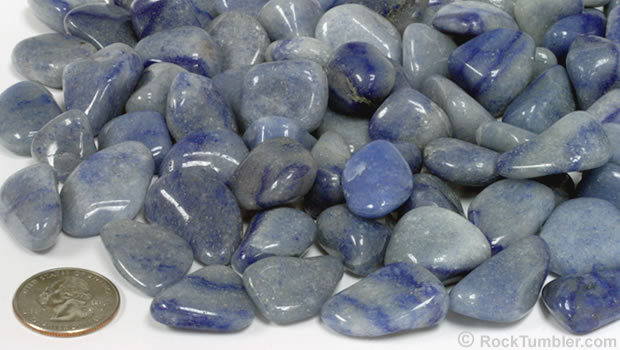

Blue Quartzite Properties | |
| What is Blue Quartzite? | Blue quartzite is a blue metamorphic rock that receives its color from tiny inclusions. These inclusions are blue prismatic crystals, which are probably dumortierite. |
| Color | Blue to bluish gray. |
| Clarity | Translucent. |
| Uses | Blue quartzite is used to make tumbled stones, beads and cabochons. |
| Weight | About 55 to 75 stones per pound. |
| Other Information | The appearance of blue quartzite varies from stone to stone. Some stones have a uniform blue color, some have an irregular distribution of blue color, and some have bands of a strong blue color. The color is determined by the presence and abundance of the blue mineral inclusions. Some people might call this material "dumortierite quartzite." |
| Locality | Unknown |
| Treatments | None known. |
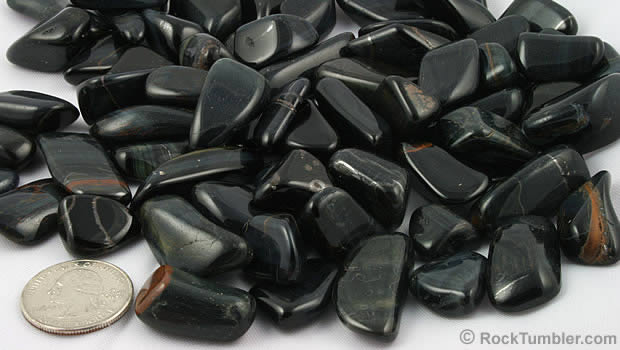

Blue Tiger's-Eye Properties | |
| What is Blue Tiger's-Eye? | Blue Tiger's-Eye is a gem material that forms when quartz replaces crocidolite. When it is polished, an "eye" can often be seen on surfaces of the stone as light reflects from the parallel fibrous structure of the stone. |
| Color | Usually a very dark blue to nearly black. |
| Clarity | Translucent to opaque. |
| Uses | Blue tiger's-eye is mainly used to make tumbled stones or cut into cabochons. The best are used in jewelry and the rest are used in craft projects. |
| Weight | About 75 to 110 stones per pound. |
| Other Information | Blue Tiger's-Eye is sometimes referred to as "Hawk's Eye." |
| Locality | South Africa |
| Treatments | None known. |
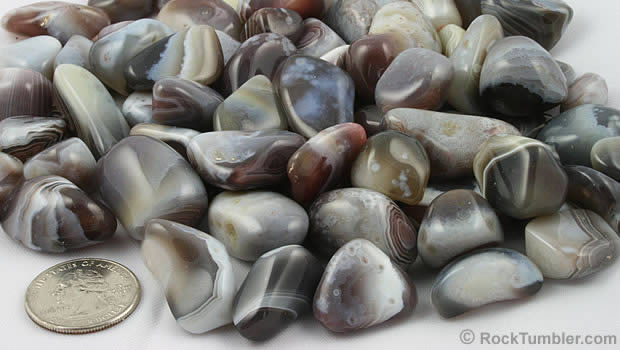

Botswana Agate Properties | |
| What is Botswana Agate? | Botswana is a country in southern Africa that is famous for banded agate. The name "Botswana Agate" is often used for gray, brown, white and sometimes orange to pinkish nodular chalcedony from that country. It can have beautiful fortification banding and sometimes displays "eyes." It usually accepts a very high polish. |
| Color | Brown, gray, cream, white, reddish |
| Clarity | Translucent to transparent. |
| Uses | Interesting pieces look great in potted plants. Tapered pieces make great pendants. Rare pieces with an "eye" are thought to be extra special. |
| Weight | About 75 to 110 stones per pound. |
| Other Information | Botswana Agate forms as nodules in basalt flows. They weather out and can be collected from soils and stream beds near the flow. The material is very durable and some can be found miles from their source. |
| Locality | Botswana, of course! |
| Treatments | None known. |
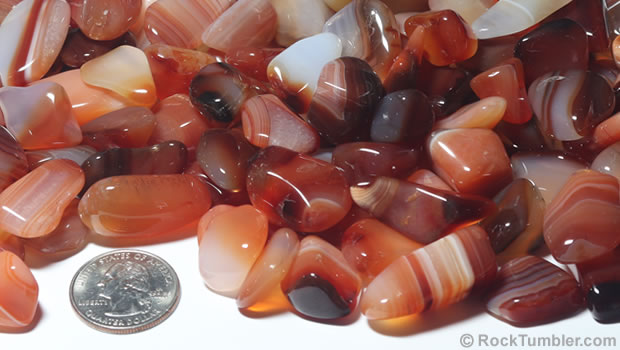

Brazilian Agate Properties | |
| What is Brazilian Agate? | "Brazilian Agate" is a name used for agate of any kind that originates from Brazil. The country is world famous for being a prolific producer of beautiful agates for over 100 years. Much of the agate from Brazil forms as geodes or nodules with subtle to striking banding. These agates occur in many colors, but red, orange, gray, white, brown, and yellow are especially abundant. The stones offered for sale here are translucent agates featuring orange, red, brown, and white bands. Their translucence is beautiful and their polish luster is spectacular. |
| Color | Banded with orange, red, brown, yellow, and white. |
| Clarity | Wonderfully translucent. |
| Uses | Makes beautiful pendants. With a Mohs hardness of 7, this stone is suitable for a wide variety of gemstone, jewelry, decor and craft projects. |
| Weight | About 70 to 95 stones per pound. |
| Other Information | The spectacular color and super-bright polish makes this one of our favorite agates. |
| Locality | Brazil. |
| Treatments | It is possible that these stones have been heated to enhance their color. This is often done with agates to make them more appealing. |
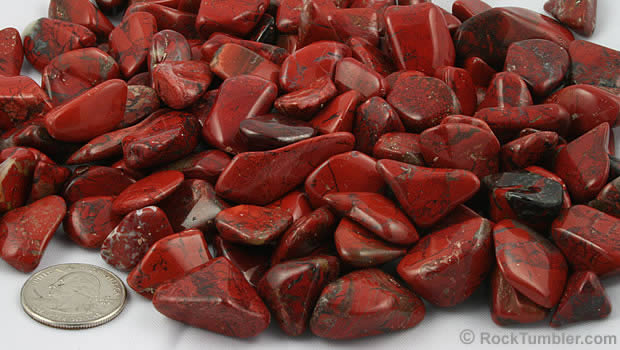

Brecciated Jasper Properties | |
| What is Brecciated Jasper? | The word "breccia" means "rock fragments." Brecciated Jasper is a chalcedony that often forms in a fracture or fault plane. When fault movement occurs the jasper is broken. Then, at a later time, mineral-rich waters flow into the fracture and deposit more chalcedony that re-cements the jasper. |
| Color | A red jasper that is re-cemented with translucent white, gray or black agate. |
| Clarity | Translucent to opaque. |
| Uses | This bright red jasper is a great ground cover in potted plants. Interesting pieces make beautiful pendants or keychains. |
| Weight | About 75 to 110 stones per pound. |
| Other Information | This material is a great visual example of how the Earth can heal itself. Jasper is one of the precious stones referred to in the Bible. |
| Locality | South Africa |
| Treatments | None known. |
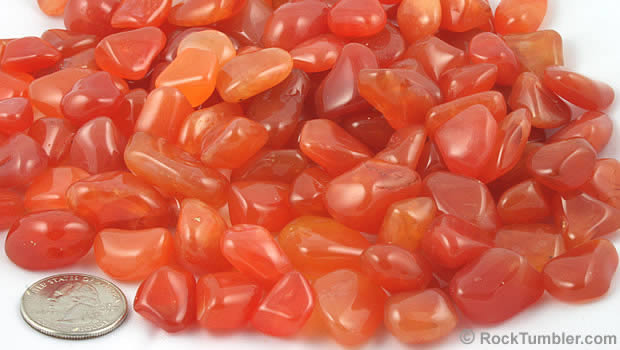

Carnelian Agate Properties | |
| What is Carnelian Agate? | Carnelian Agate is the name given to a translucent variety of chalcedony that is orange, red or reddish brown in color. It is an exceptionally popular gemstone and has been used for jewelry and adornments for thousands of years. |
| Color | Orange, red or reddish brown. |
| Clarity | Translucent. |
| Uses | The gemmy color of this material attracts attention and makes it a favorite stone in gemstone, craft, jewelry and decorative projects. The great color makes an attractive pendant. Great as an accent stone in displays. Some people have purchased these tumbled stones from us, sliced them into thin slabs and used them to cut cabochons. That's how nice it is. |
| Weight | About 75 to 110 stones per pound. |
| Other Information | Trivia: Carnelian is one of the precious stones referred to in the Bible. |
| Locality | Botswana, a country in southern Africa. |
| Treatments | None known for this material. However, much carnelian has been heated to improve its color. We would not be surprised if this material was treated. |
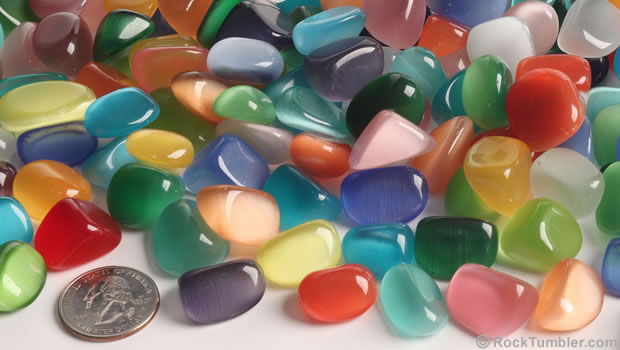

Cat's-Eye Glass Properties | |
| What is Cat's-Eye Glass? | Cat's-Eye Glass is a man-made material and a byproduct of the fiber optics industry. It is a glass that is filled with parallel bundles of optical fibers. When a beam of light enters the glass and strikes these fibers, it reflects from them. Because the fibers are straight and parallel, the light that hits them has a common angle of incidence and a common angle of reflection. As a result, the reflections produce a bright line of light perpendicular to the fibers that spans the surface of the stone. On a convex surface, this phenomenon is known as a "cat's eye". It is the same as the gemstone phenomenon known as "chatoyance" which is displayed in familiar gems such as tiger's-eye and cat's-eye chrysoberyl. |
| Color | Each package contains a wide range of beautiful colors. |
| Clarity | Translucent to transparent. |
| Uses | In the gem and jewelry industry, cat's-eye glass is often fashioned into cabochons, beads, and tumbled stones. Many people like them because they display a strong chatoyant phenomenon. The chatoyance, combined with their beautiful colors, produces an eye-attracting display when set in jewelry. |
| Weight | About 75 to 95 stones per pound. |
| Other Information | Cat's-Eye Glass is available in 1/4, 1/2, and 1 pound packages that each contain pieces of glass in a variety of colors, randomly drawn when the glass is packaged. We are unable to supply stones of specific colors. All packages contain an assortment of colors with some duplication. |
| Locality | Cat's-eye glass is a man-made product manufactured in China. |
| Treatments | None known. |
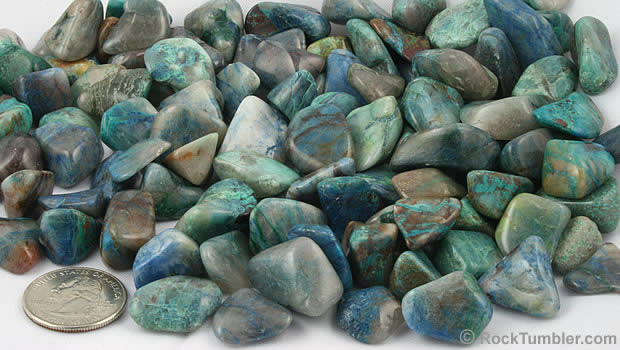

Chrysocolla in Quartz Properties | |
| What is Chrysocolla in Quartz? | Chrysocolla is a vivid blue to blue-green copper mineral that often occurs as inclusions and veins through quartz or chalcedony. |
| Color | A blend of blue to blue-green to green chrysocolla in white to clear quartz. |
| Clarity | Translucent to opaque. |
| Uses | Suitable for a variety of gemstone, jewelry, craft and decorative projects. |
| Weight | About 75 to 110 stones per pound. |
| Other Information | Chrysocolla in Quartz can be a beautiful material. Polished specimens frequently display colorful patterns of blue-green veins, swirls and bands of chrysocolla through transparent to milky quartz. Chrysocolla itself is not well-suited as a gemstone, as it is often brittle and has a hardness of only 2 to 4 on the Mohs scale. However, when combined with quartz or chalcedony, the resulting rock can be hard enough and durable enough for use as a gemstone. |
| Locality | Namibia. |
| Treatments | None known. |
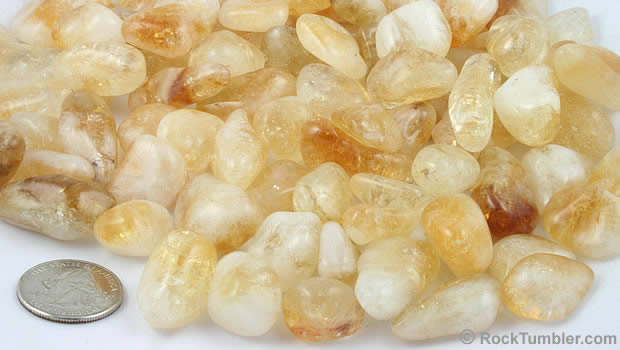

Citrine Quartz Properties | |
| What is Citrine Quartz? | Citrine is the name used for quartz with a yellow to golden color. The name is derived from the word "citrus." |
| Color | This citrine is a yellow to golden color with some milky white areas. |
| Clarity | Transparent to translucent. |
| Uses | This citrine is suitable for a variety of gemstone, craft, jewelry and decorative projects. We think that it makes a nice vase filler. |
| Weight | About 75 to 110 stones per pound. |
| Other Information | Citrine Quartz is designated as a November birthstone and is also a traditional gift on a 13-year anniversary. |
| Locality | Brazil. |
| Treatments | Much of the citrine quartz in the market today is produced by heating amethyst. This heating can be natural or done by people. We would not be surprised if this citrine has been heated. |
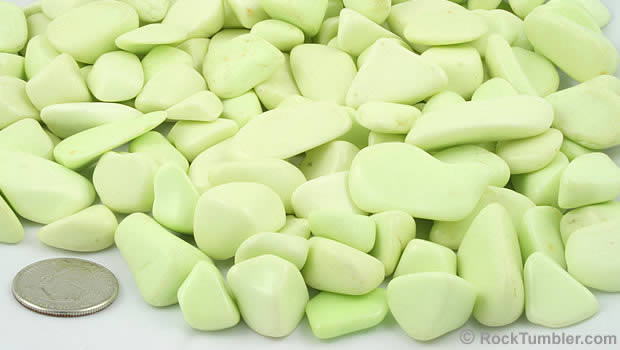

Citron Magnesite Properties | |
| What is Citron Magnesite? | This material is usually referred to as "citron chrysoprase" or "lemon chrysoprase" (or a similar name) in much of the world. The names "lemon" and "citron" are inspired by the color of this material being similar to those citrus fruits. The material that we are selling here, and much of the material being sold elsewhere, is primarily magnesite. Why do we think it is mainly magnesite? It has a Mohs hardness of about 5 (chrysoprase should have a hardness of about 7), it exhibits birefringence blink on a refractometer (chrysoprase should not), and a drop of dilute HCl placed on powdered material produces a weak effervescence (magnesite produces a weak reaction with HCl but chrysoprase has no reaction). This material is magnesite that has likely experienced some silicification. We sent one of these stones to the Gemological Institute of America's laboratory and asked them to identify it. They identified it as "a member of the Magnesite-Gaspeite series". You can see the report here. |
| Color | Bright yellow-green. |
| Clarity | Translucent to opaque. |
| Uses | Makes wonderful pendants and keychains. Also great as a vase filler and as a ground cover in potted plants. Works well in most gemstone, jewelry, craft or decor projects. |
| Weight | About 75 to 110 stones per pound. |
| Other Information | This material has a matte finish that is commonly seen on polished magnesite. We sent a specimen of this material to the Gemological Institute of America for identification, and they said that it was in the magnesite to gaspeite series with a possible surface treatment to improve its luster. |
| Locality | Australia. |
| Treatments | Possible luster enhancement. |
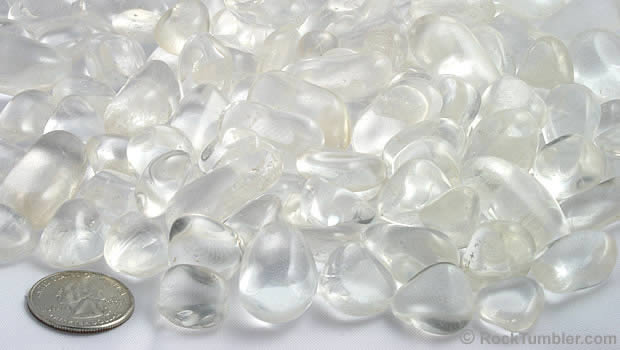

Clear Quartz Properties | |
| What is Clear Quartz? | "Crystal quartz," "rock crystal," and "clear quartz" are all names used for transparent quartz. Although you would think that it would be hard for a colorless material to have beauty, you will find that attractive appearance here. |
| Color | Colorless. |
| Clarity | Absolutely transparent. |
| Uses | Lots of people use it as accents in jewelry displays. Makes a great vase filler. |
| Weight | About 75 to 110 stones per pound. |
| Other Information | Trivia: "Crystal" is one of the precious stones referred to in the Bible - that reference was most likely to crystalline quartz. |
| Locality | Madagascar. |
| Treatments | None known. |
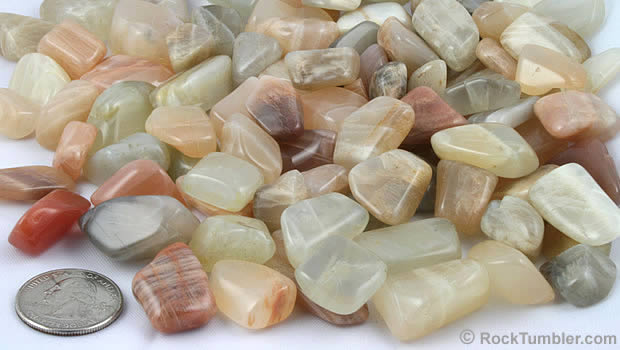

Colored Moonstone Properties | |
| What is Colored Moonstone? | Moonstone is a gemstone of the feldspar mineral family. It is a material that consists of finely interlayered orthoclase and albite. Light entering the stone is scattered as it passes through alternating layers of the orthoclase and albite, and that scattered light produces a glow known as "adularescence." This glow seems to float just under the surface of the stone. The glow reminds some people of the glow of a full moon - this is how the name "moonstone" originated. |
| Color | A wide range of colors that include white, gray, beige, tan, pink, and peach. |
| Clarity | Translucent. |
| Uses | Nice pieces make great pendants. A beautiful vase filler. Attractive as ground cover in potted plants. Great in decor, craft and jewelry projects of all kinds. |
| Weight | About 75 to 110 stones per pound. |
| Other Information | Feldspar minerals cleave in two directions at right angles. Because of that, tumbled moonstone usually has a "blocky" shape. The "glow" can be seen on two of the block's "faces." If you see the glow, flip the stone over and a similar glow should be seen on the opposite side of the stone. |
| Locality | India. |
| Treatments | None known. |

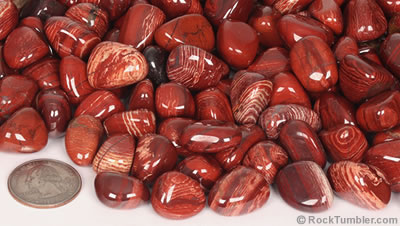
Convoluted Jasper Properties | |
| What is Convoluted Jasper? | Convoluted Jasper is a true jasper that is named for the convoluted bands and layers that cross the stones. The jasper is various colors of brownish red to dark red with fine bands and layers of white, cream, and brown. This material has an exceptionally bright polish. |
| Color | A red background color with fine bands of white, cream, and brown. |
| Clarity | Opaque. |
| Uses | Suitable for a wide variety of gemstone, jewelry, decor and craft projects. |
| Weight | About 50 to 75 stones per pound. Some of these stones contain particles of finely disseminated hematite. Hematite has a high specific gravity, and that makes these stones weigh more than stones of similar size that are composed of jasper. |
| Other Information | The stones in this batch have very pleasing shapes and an exceptionally bright polish. |
| Locality | Not known. |
| Treatments | None known. |
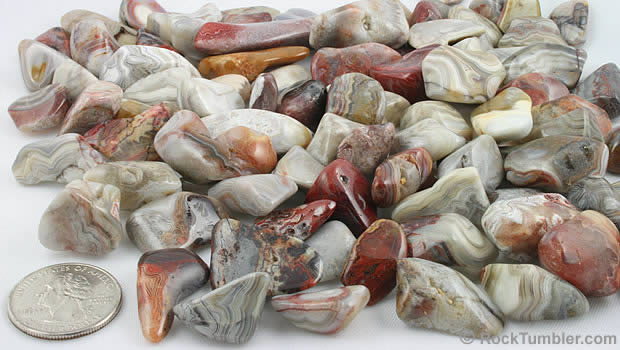

Crazy Lace Agate Properties | |
| What is Crazy Lace Agate? | Crazy Lace Agate is a white to gray botryoidal agate with colorful stains that are usually yellow, orange, red, and brown in color and probably caused by iron. When used to produce cabochons, beads, tumbled stones and other lapidary products, their polished surfaces usually exhibit a lace-like pattern of curves and eyes. |
| Color | A white to gray bodycolor with yellow, orange, red, and brown stains. |
| Clarity | Translucent to opaque. |
| Uses | Crazy Lace is a popular agate for producing cabochons, beads and tumbled stones. |
| Weight | About 75 to 110 stones per pound. |
| Other Information | Crazy Lace sometimes contains vugs which can be coated with a quartz crystal druze. These are often incorporated into the design of a cabochon to give the gem a glittering focal point. |
| Locality | Mexico has long been a source of Crazy Lace Agate. |
| Treatments | None known for this material. However, crazy lace agate is sometimes dyed to produce a very colorful stone with an interesting pattern. |
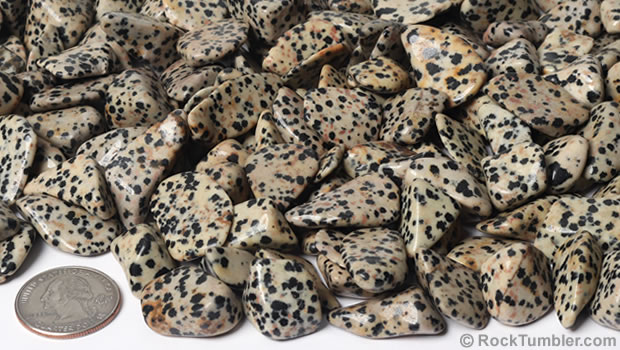

Dalmatian Stone Properties | |
| What is Dalmatian Stone? | "Dalmatian Stone" is an igneous rock that was named after the Dalmatian breed of dogs, due to its spotted appearance. It has been a popular material among lapidarists for many years. Some people call this material "Dalmatian jasper" - but that is actually an incorrect name because this material is not a jasper. If you would like to learn more about the mineralogical composition of Dalmatian stone, please check out our article on the subject. |
| Color | Cream-colored feldspar and quartz, spotted with black arfvedsonite. |
| Clarity | Opaque. |
| Uses | Suitable for a wide variety of gemstone, jewelry, decor and craft projects. |
| Weight | About 70 to 90 stones per pound. |
| Other Information | Dalmatian stone accepts dye readily. It is often dyed bright colors such as red, green, blue, or purple, and can be found in the popular "souvenir mix" tumbled stones at many gift shops. |
| Locality | Mexico. |
| Treatments | None known. |

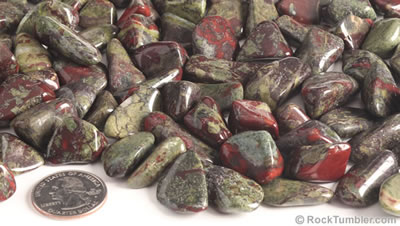
Dragon Blood Properties | |
| What is Dragon Blood? | "Dragon Blood" is a marketing name for a rock composed mainly of green epidote, with lesser amounts of red manganese-rich epidote (that is commonly called "piemontite"), plus other minerals. The name dragon blood fits this stone. The name probably originated from its mix of dragon-green epidote, splashed with blood-red color. Some people call this material "dragon stone" (which is a fine name) or "dragon blood jasper" (which is an incorrect name because this material is not a jasper). |
| Color | Dark green epidote and brownish red epidote with specks and swirls of other minerals. |
| Clarity | Translucent to opaque. |
| Uses | Suitable for a wide variety of gemstone, jewelry, decor and craft projects. |
| Weight | About 75 to 110 stones per pound. |
| Other Information | A stone that many people have never seen. The name "dragon blood" attracts curiosity and attention. |
| Locality | Australia. |
| Treatments | None known. |
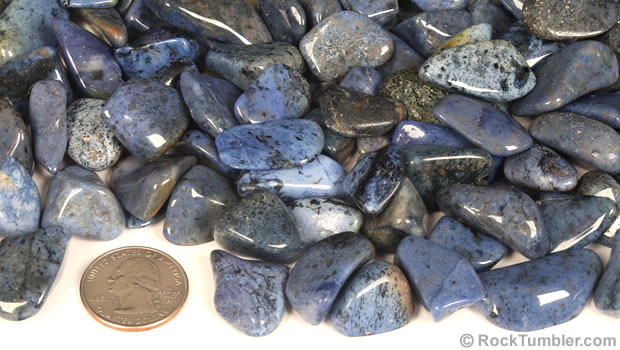

Dumortierite Properties | |
| What is Dumortierite? | Dumortierite is a rare aluminum borate silicate mineral that is found in metamorphic rocks. It is hard and durable - much like jade has those properties. |
| Color | Blue, violet blue, greenish blue to gray. |
| Clarity | Translucent to opaque. |
| Uses | Great for keychains, ground cover in potted plants, vase filler and craft projects. Not often seen as a tumbled stone. |
| Weight | Dumortierite has a density that is slightly higher than most other stones. For that reason, there are only about 50 to 90 stones per pound. |
| Other Information | Often forms as tiny inclusions in quartz. When they are abundant enough, the quartz can have a distinctly blue color. Dumortierite is used in industry to make the porcelain parts of spark plugs. |
| Locality | Mozambique. |
| Treatments | None known. |
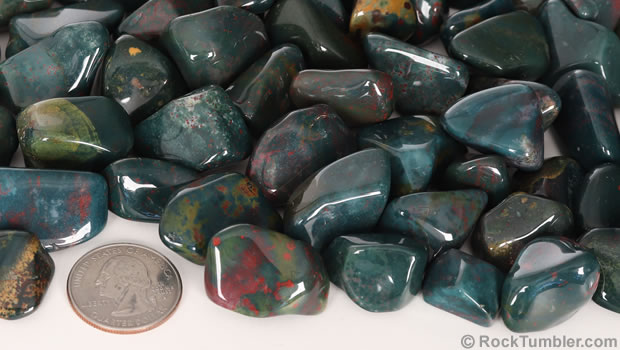

Fancy Jasper Properties | |
| What is Fancy Jasper? | The name "Fancy Jasper" can have a wide variety of meanings. However, it is most often used as a marketing name for very dark green jasper marked with white, yellow, and red markings, found in India. The stones offered for sale here are a very dark green and are lightly splashed with yellow, white and red (the word lightly here means both light density and light color). A person who searches through a pound of these stones might find nice examples of "plasma" (dark green jasper with light splashes of yellow or white) or "bloodstone" (dark green jasper lightly splashed with red or brownish red). |
| Color | Dark green jasper lightly splashed with small patches of red, white and yellow. |
| Clarity | Opaque. |
| Uses | With a Mohs hardness of 7, these stones are suitable for a wide variety of gemstone, jewelry, decor and craft projects. |
| Weight | About 60 to 90 stones per pound. |
| Other Information | This is a stone that originates in India and has been a common tumbled stone from that country for decades. |
| Locality | India. |
| Treatments | None known. |
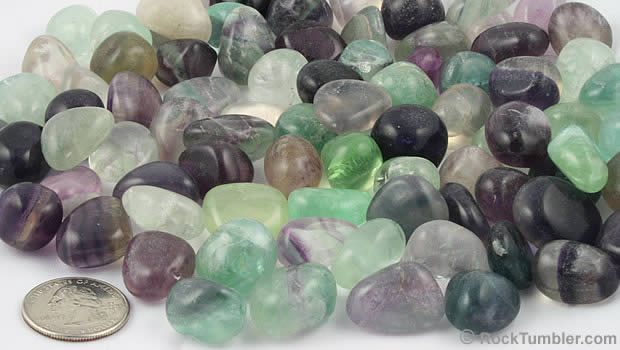

Fluorite Properties | |
| What is Fluorite? | Fluorite is a mineral composed of calcium and fluorine. It occurs in a variety of beautiful colors that inspire people to use it as a gemstone or in making ornamental objects. |
| Color | Fluorite ranges from clear to yellow to green to blue to purple in saturations that are so light that the stones are as transparent as crystal to so dark that the stones are barely translucent. People are delighted by this range of color and diaphaneity, and that is part of what makes fluorite a desirable gemstone material. Some stones are a solid color, while others are banded with two or more colors present in a single stone. |
| Clarity | Transparent, translucent and almost opaque. |
| Uses | A beautiful material for craft and decor projects. Be careful, however, because it has a Mohs hardness of only 4 and is easily scratched. |
| Weight | Fluorite has a density that is slightly higher than most other stones. About 60 to 90 stones per pound. |
| Other Information | Fluorite is a soft stone with cleavage. Thus it should not be placed in uses where it will be subject to abrasion or impact. |
| Locality | China. |
| Treatments | None known. |
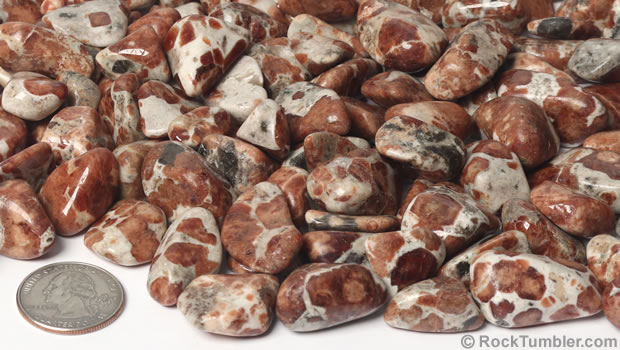

Garnet Crystals in Wollastonite Properties | |
| What are Garnet Crystals in Wollastonite? | This is another geologically interesting stone. It formed when a subsurface body of magma (molten rock) moved into contact with a layer of limestone. Hot acidic fluids from the magma came into contact with the limestone, and a high temperature / high pressure reaction occurred with tremendous effervescence... and a new metamorphic rock called "skarn" was formed.
These specimens of skarn consist of white to gray wollastonite that is packed absolutely full of reddish brown garnet crystals. Some of the garnet crystals have geometric outlines. Others are intimately intergrown with their neighbors. (We have an article about "skarn" on our Geology.com website if you would like to read more. Many types of gemstones are found in skarns.) |
| Color | Reddish brown garnet crystals in white to gray wollastonite. |
| Clarity | Translucent to opaque. |
| Uses | This material makes interesting tumbled stones and cabochons. It is durable and suitable for a variety of jewelry and decorative uses. |
| Weight | About 50 to 65 stones per pound. |
| Other Information | If you are sensitive to the specific gravity of stones, the garnet crystals make these stones feel a little heavier than expected. |
| Locality | Unknown. |
| Treatments | We believe that the stones we are selling have their natural color - meaning they are untreated. |
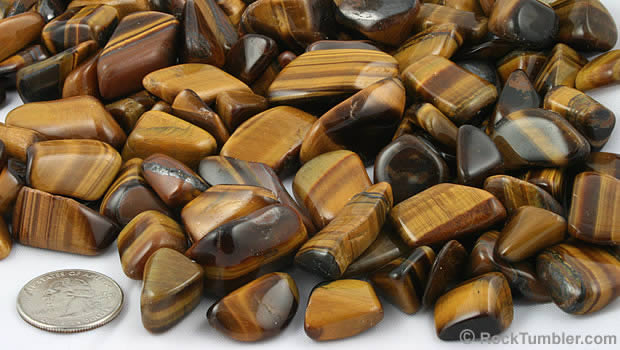

Gold Tiger's-Eye Properties | |
| What is Gold Tiger's-Eye? | Tiger's-Eye receives its name from the way that light interacts with the stone. When moved under a bright light such as direct sunlight or a bright lamp in the room, the fibers in the stone reflect a line of light that moves across the surface of the stone when it is moved. The line of light reminds people of the line-shaped pupil in the eye of a tiger - thus the name. |
| Color | Honey brown to dark brown to golden brown |
| Clarity | Translucent to opaque. |
| Uses | Gold Tiger's-Eye is a popular stone. It is used as a decor item, to make keychains and pendants, and the stone is a favorite for jewelry making and crafts. |
| Weight | About 75 to 110 stones per pound. |
| Other Information | The "eye" produced when light is reflected from Tiger's-Eye is a phenomenon known as "chatoyancy." In most specimens of Tiger's-Eye, the fiber-shaped structures are curved or bent. This can cause the eye to bend or change orientation when the stone is played in the light. In some specimens the fiber-shaped structures are divided into multiple bands. This produces multiple lines of light, or "eyes," when the stone is played in the light. |
| Locality | South Africa. |
| Treatments | None known. |
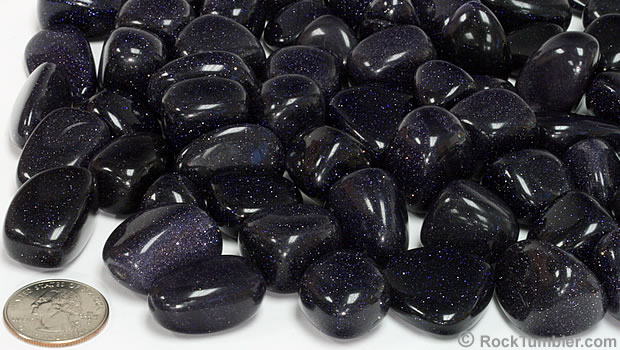

Blue Goldstone Properties | |
| What is Goldstone? | Goldstone is a man-made glass that contains abundant, highly reflective crystals with a bright metallic luster. The blue color of this material is caused by small amounts of cobalt in the glass. |
| Color | Dark blue. |
| Clarity | Translucent to opaque. |
| Uses | Goldstone is a popular material for making beads, cabochons, tumbled stones and a wide variety of other art objects. |
| Weight | About 30 to 50 stones per pound. |
| Other Information | The sparkling appearance of goldstone is known as "aventurescence." That word is derived from the name "aventurine" which was given to this material by Italian glass makers. The mineral material known as "aventurine" receives its name from the same source. |
| Locality | Today, most goldstone is manufactured in China. We believe that this material is Chinese goldstone. |
| Treatments | A man-made material. No known treatments. |
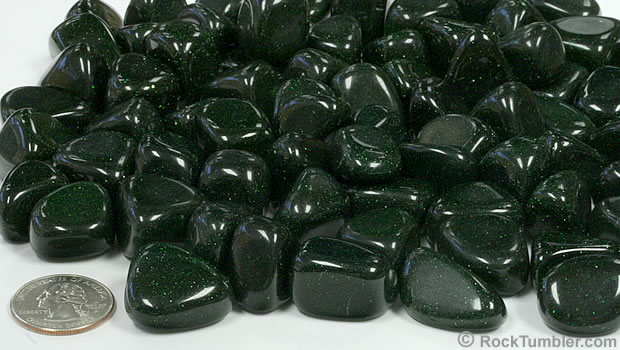

Green Goldstone Properties | |
| What is Goldstone? | Goldstone is a man-made glass that contains abundant, highly reflective crystals with a bright metallic luster. The green color of this material is caused by small amounts of chromium in the glass. |
| Color | Dark green. |
| Clarity | Translucent to opaque. |
| Uses | Goldstone is a popular material for making beads, cabochons, tumbled stones and a wide variety of other art objects. |
| Weight | About 30 to 50 stones per pound. |
| Other Information | The sparkling appearance of goldstone is known as "aventurescence." That word is derived from the name "aventurine" which was given to this material by Italian glass makers. The mineral material known as "aventurine" receives its name from the same source. |
| Locality | Today, most goldstone is manufactured in China. We believe that this material is Chinese goldstone. |
| Treatments | A man-made material. No known treatments. |
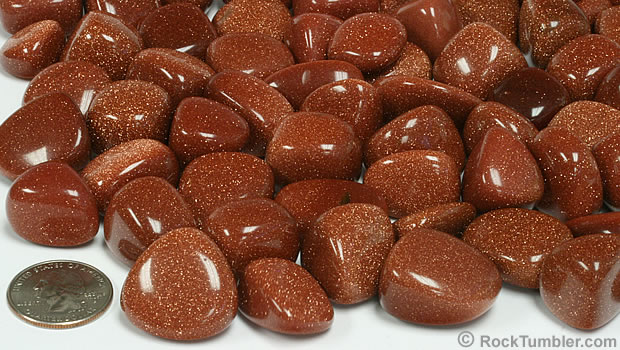

Reddish Brown Goldstone Properties | |
| What is Goldstone? | Goldstone is a man-made glass that contains abundant, highly reflective crystals with a bright metallic luster. The reddish brown color in this material is caused by reflections from the crystals, which are composed of copper. |
| Color | Reddish brown |
| Clarity | Translucent to opaque. |
| Uses | Goldstone is a popular material for making beads, cabochons, tumbled stones and a wide variety of other art objects. |
| Weight | About 30 to 50 stones per pound. |
| Other Information | The sparkling appearance of goldstone is known as "aventurescence." That word is derived from the name "aventurine" which was given to this material by Italian glass makers. The mineral material known as "aventurine" receives its name from the same source. |
| Locality | Today, most goldstone is manufactured in China. We believe that this material is Chinese goldstone. |
| Treatments | A man-made material. No known treatments. |
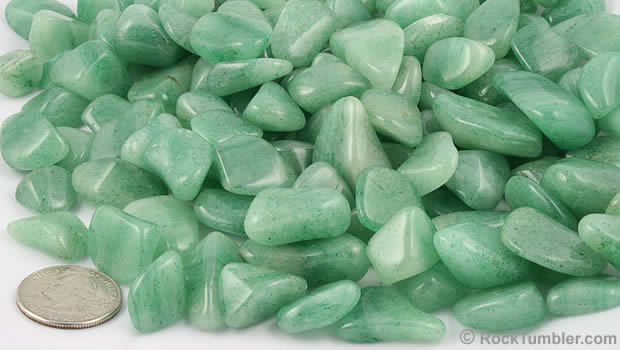

Green Aventurine Properties | |
| What is Green Aventurine? | Aventurine, sometimes called "aventurine quartz," is a variety of translucent quartz that exhibits a "glittery" appearance when it is moved under a light or when the angle of observation changes. When light penetrates the stone, some of it encounters tiny mineral crystals which reflect the light and make the stone sparkle. In green aventurine the tiny crystals are usually a mineral known as fuchsite, a green mica that is highly reflective. The fuchsite crystals give green aventurine both its color and its glittery appearance - known as "aventurescence." |
| Color | Green, sometimes variegated to make the stone appear slightly banded. |
| Clarity | Translucent. |
| Uses | This is nice gemmy aventurine that makes wonderful pendants and keychains. Makes a great vase filler or a scatter of stones in a centerpiece or display. |
| Weight | About 75 to 110 stones per pound. |
| Other Information | The name "aventurine" is from the glass industry. In the early 1700's glass artists in Italy were producing glass with a metallic glitter known as "aventurine glass." This glass is what inspired the use of the name "aventurine" for a gemstone. Some people always use the name "aventurine quartz" to avoid any confusion in communication. |
| Locality | Zimbabwe. |
| Treatments | None known. |
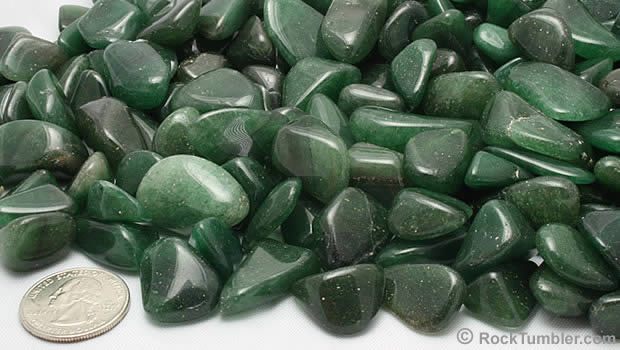

Dark Green Aventurine Properties | |
| What is Dark Green Aventurine? | Aventurine, sometimes called "aventurine quartz," is a variety of translucent quartz that exhibits a "glittery" appearance when it is moved under a light or when the angle of observation changes. When light penetrates the stone, some of it encounters tiny mineral crystals which reflect the light and make the stone sparkle. In green aventurine the tiny crystals are usually a mineral known as fuchsite, a green mica that is highly reflective. The fuchsite crystals give green aventurine both its color and its glittery appearance - known as "aventurescence." |
| Color | Green, sometimes variegated to make the stone appear slightly banded. |
| Clarity | Translucent. |
| Uses | This is nice gemmy aventurine that makes wonderful pendants and keychains. Makes a great vase filler or a scatter of stones in a centerpiece or display. |
| Weight | About 75 to 110 stones per pound. |
| Other Information | The name "aventurine" is from the glass industry. In the early 1700's glass artists in Italy were producing glass with a metallic glitter known as "aventurine glass." This glass is what inspired the use of the name "aventurine" for a gemstone. Some people always use the name "aventurine quartz" to avoid any confusion in communication. |
| Locality | Zimbabwe. |
| Treatments | None known. |
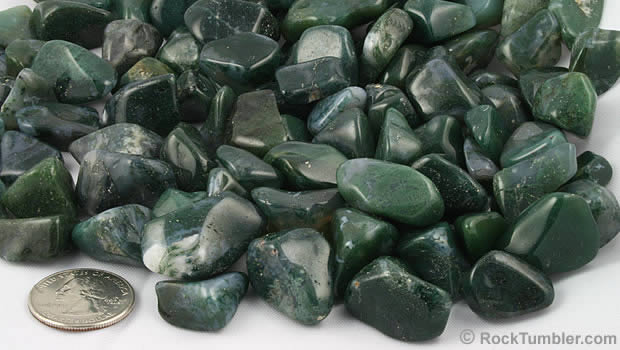

Green Moss Agate Properties | |
| What is Green Moss Agate? | Green Moss Agate is a transparent to translucent agate that contains inclusions shaped like trees, ferns, leaves, moss or other vegetation. These inclusions are generally mineral material such as iron oxide or manganese oxide. |
| Color | Dark green, with some white to gray quartz or chalcedony. |
| Clarity | Translucent. |
| Uses | Makes a great ground cover in potted plants. Works well in a variety of craft and decor projects. |
| Weight | About 75 to 110 stones per pound. |
| Other Information | Very similar to Green Tree Agate - but green tree agate has mostly milky white quartz with a few green inclusions. |
| Locality | India. |
| Treatments | None known. |
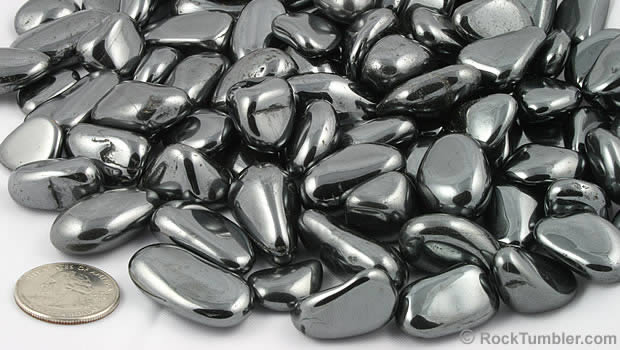

Hematite Properties | |
| What is Hematite? | Our tumbled Hematite gemstones have a mirror-bright silver-metallic luster that beautifully reflects the light. Hematite is an ore of iron, and you will immediately sense a weighty feel when you pick up one of these tumbles. They feel heavy because hematite has a density that is about twice that of most other tumbled stones. |
| Color | Bright silver in color. |
| Clarity | Opaque. |
| Uses | These stones are perfect for a variety of jewelry, decorative and craft projects - or simply to admire. |
| Weight | Hematite is an iron ore and is very heavy. This causes it to have much fewer stones per pound than other stone varieties that we sell. About 35 to 55 stones per pound. |
| Other Information | Before the invention of plate glass, pieces of reflective Hematite were often used as mirrors. Hematite jewelry was most popular during Victorian times, but it is currently seeing a resurgence. |
| Locality | Brazil. |
| Treatments | None known. |


Jet Properties | |
| What is Jet? | Jet is a black organic rock that has an origin similar to coal. Both form from plant debris. Coal forms in seams where a large amount of plant debris accumulates; however, jet forms when single logs or branches are preserved. |
| Color | Black. The phrase "jet black" was inspired by this material. |
| Clarity | Opaque. |
| Uses | People have been using jet as an ornamental and jewelry material since the stone age. The Romans began mining jet in what is now the United Kingdom over 1000 years ago. The most famous locality, Whitby, in the United Kingdom is where the most famous deposits are located. It reached its pinnacle of popularity in the mid-1800s when Queen Victoria wore jet as "mourning jewelry." In the early 1900s jet beads were popular in the United States. At that time wearing several long bead strands was popular and jet, because of its light weight, was a comfortable material to wear. |
| Weight | About 60 to 80 stones per pound. |
| Other Information | Jet has a very low density of about 1.3 to 1.4. That is about half the density of quartz. Jet beads in very long strands are much more comfortable to wear because of this low density. |
| Locality | Unknown. |
| Treatments | None known. |
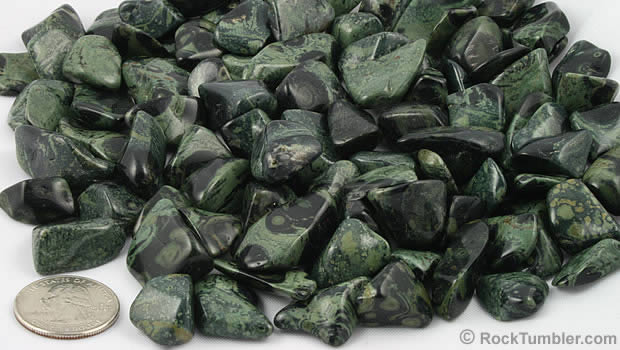

Kambaba Properties | |
| What is Kambaba? | Kambaba is a unique material. It is dark green in color and marked with black orbs and swirls. It is a jasper-like material, hard and durable. It polishes to a beautiful bright luster. It is also known as Kambamba and Crocodile Stone. The crocodile name originated when some people thought that the green color of the stone combined with the black orbs looked like crocodile eyes. |
| Color | Dark green with black markings. |
| Clarity | Opaque |
| Uses | Used for a variety of gemstone, jewelry and craft projects. |
| Weight | About 75 to 110 stones per pound. |
| Other Information | Kambaba is not a jasper. Instead, it is a rhyolite composed mainly of quartz and feldspar minerals. But it also has minute clusters of green amphibole crystals - arranged in a radial structure - and some fine-grained pyroxene minerals. |
| Locality | Madagascar. |
| Treatments | None known. |
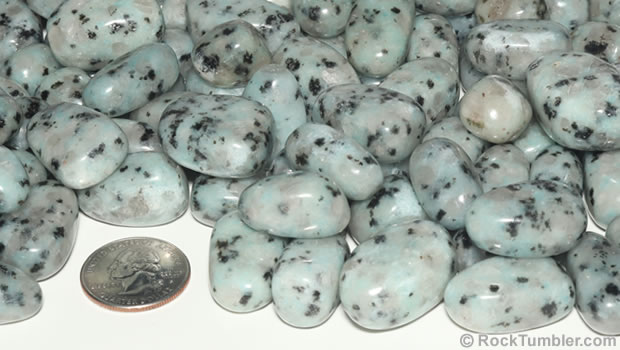

Kiwi Stone Properties | |
| What is Kiwi Stone? | "Kiwi Stone" is a spotted stone, with black spots on a background of faint bluish green. Technically, it is a metamorphic rock known as quartzite. It forms by metamorphism of a sedimentary rock composed mainly of small quartz pebbles, finer quartz material, and clay minerals. If you look at the stone you can see remnants of the quartz pebbles, surrounded by the finer quartz material with a slightly bluish green color. The black spots are clusters and books of chlorite crystals. It is called "Kiwi Stone" because it is reportedly from New Zealand. Some people call it "Kiwi Jasper" but jasper is an incorrect name for this material. |
| Color | A faint bluish green color with black spots. |
| Clarity | Translucent to opaque. |
| Uses | Suitable for a wide variety of gemstone, jewelry, decor and craft projects. |
| Weight | About 40 to 60 stones per pound. |
| Other Information | The stones in this batch have a very pleasing ovoid shape. |
| Locality | New Zealand. |
| Treatments | None known. |
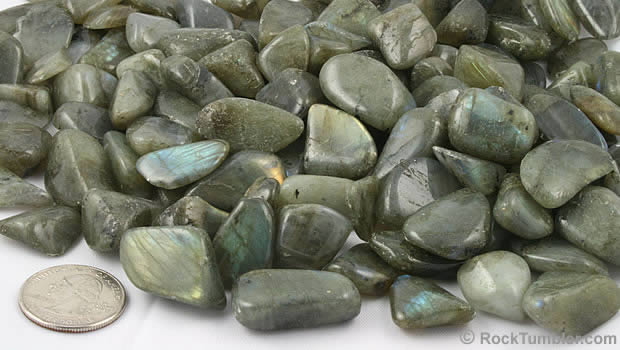

Labradorite Properties | |
| What is Labradorite? | Labradorite is a variety of plagioclase feldspar that is widely known for its spectacular display of color in reflected light. When the mineral is moved under incident light, it produces flashes of iridescent blue, green, yellow or orange. This optical effect is known as "labradorescence" and is caused when planes within the mineral reflect specific colors of light. Labradorescence can be seen in some of the stones in the image here. If these stones were in front of you and you moved the light source, other stones would have the proper angle of incidence to display the iridescent flash. That could also occur by moving your head or moving the stones. Most of these stones display labradorescence if viewed with the proper angle between stone, light source, and observer. |
| Color | Greenish with bright yellow, orange, red, blue and green labradorescent flashes. |
| Clarity | Translucent to opaque. |
| Uses | Nice pieces make attractive earrings and pendants. Used in a variety of craft projects. |
| Weight | About 75 to 110 stones per pound. |
| Other Information | Labradorite has perfect cleavage and because of that, most tumbled stones will have a few rough spots. |
| Locality | Madagascar. |
| Treatments | None known. |
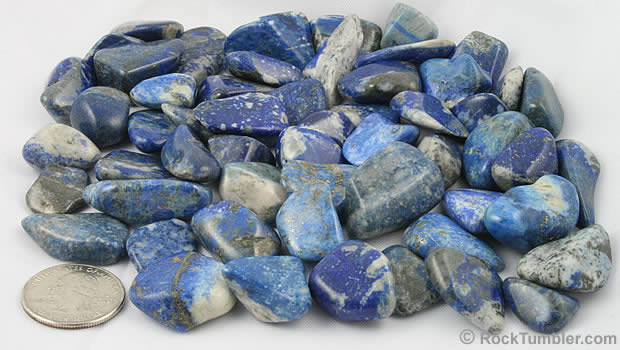

Lapis Lazuli Properties | |
| What is Lapis Lazuli? | Lapis Lazuli is a rock composed of the minerals lazurite, sodalite, calcite and hauyne - and occasionally with some gold-colored inclusions of pyrite. It is mined in small amounts in just a few countries - including Afghanistan, Chile, and Russia. Some areas in Afghanistan have produced Lapis Lazuli for over 6,000 years. |
| Color | Various shades of blue with other minerals of white and gray color. Some pieces have gold flashes of pyrite. |
| Clarity | Opaque. |
| Uses | Nice pieces of lapis make great pendants. A couple interesting pieces of lapis lazuli are nice to have on your desk or on a shelf. Great for a variety of gemstone, decor, jewelry or craft projects. |
| Weight | About 75 to 110 stones per pound. |
| Other Information | The bright blue color of Lapis Lazuli has made it one of the most popular semiprecious stones of all time. It has been treasured and traded by people since Biblical times. The name of this gemstone comes from two Latin words: "lapis" is the Latin word for "stone," and "lazuli" is derived from the Latin word for "blue." The blue stone! |
| Locality | Chile. |
| Treatments | None known. |

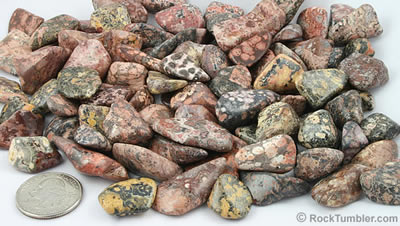
Leopard Skin Properties | |
| What is Leopard Skin? | One look at Leopard Skin and you will know how it received its name. It looks like the coat of a leopard, complete with the round "rosette" markings that we commonly call "spots." Some specimens have the brown, tan, cream and black color palette that is a close match with the color of many leopards. Others have a red, pink, white and black palette. |
| Color | Tan, brown, white, black, pink and red colors in a leopard skin pattern. |
| Clarity | Opaque. |
| Uses | Makes a nice ground cover in potted plants. Excellent pieces make interesting pendants or keychains. Put some in a wooden bowl on a table and visitors will pick them up and ask, "What is this stuff?" |
| Weight | About 75 to 110 stones per pound. |
| Other Information | Some geologists believe that Leopard Skin is derived from rhyolite, an igneous rock that forms during the rapid cooling of molten rock material. The rhyolite is then altered by hot, mineral-rich waters to form the patterned and colorful rock that we call "Leopard Skin." Minerals which precipitated from the hot water produce the spherical and botryoidal structures that create the "spots" that give leopard skin its name. Because this material is not a chalcedony, the traditionally used name of "Leopard Skin Jasper" is not appropriate. To be called "jasper," the material should be composed of chalcedony. It would then have a smooth texture, a conchoidal fracture, and a hardness of approximately seven on the Mohs hardness scale. Leopard skin generally does not exhibit these characteristics. It is often grainy with some euhedral crystals visible on hand lens examination; almost anywhere you test it the hardness is less than seven. So, we do not use the name "jasper" with this material. "Leopard Stone" or "Leopard Skin Stone" are more appropriate names - at least for the material being sold here. |
| Locality | Mexico. |
| Treatments | None known. |
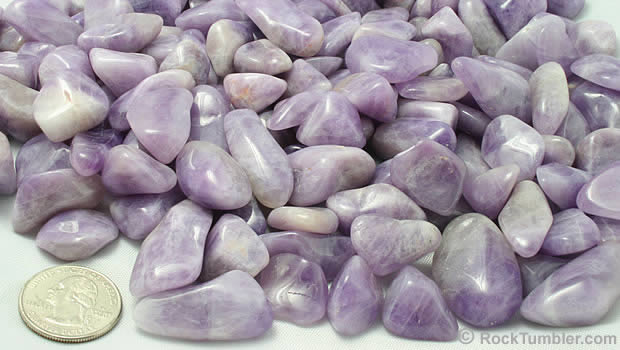

Lilac Amethyst Properties | |
| What is Lilac Amethyst? | Amethyst is variety of quartz with a purple color that is very popular in jewelry. The purple color is often caused by iron or other trace elements within the quartz. |
| Color | Purple. |
| Clarity | Translucent. |
| Uses | Very popular in jewelry. As a gemstone it has been enjoyed by people for thousands of years. The ancient Egyptians, Greeks, and Romans all used amethyst in jewelry and in ornamental objects. At that time, amethyst was a rare gemstone and valued highly. Then in the 1800s and 1900s, large deposits of amethyst were discovered in Brazil, Uruguay, South Africa, India, Russia and other countries. These discoveries lowered the cost of amethyst and made it a much more accessible gemstone for consumers. Today it is the semi-precious gemstone for the month of February and that has driven its popularity. |
| Weight | About 75 to 110 stones per pound. |
| Other Information | Wow! Was our reaction when we saw this material. It is beautiful. Trivia: Amethyst is one of the traditional precious stones referred to in the Bible. |
| Locality | South Africa. |
| Treatments | None known. |
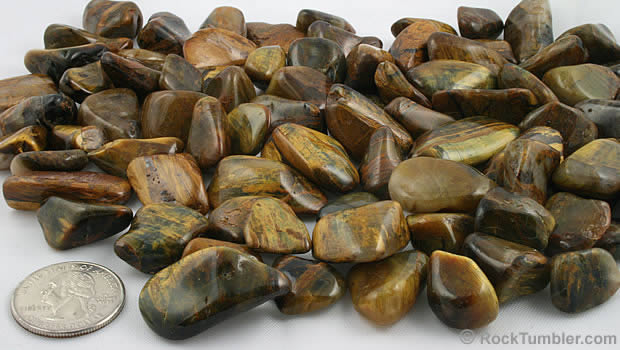

Lionskin Properties | |
| What is Lionskin? | Lionskin is a name used for a chalcedony that contains a significant amount of included material. In some areas the included material is the same aligned fibers that produce the chatoyance of Golden Tiger's-Eye. In other areas the included material has a woody appearance. Some pieces of the material appear to be a breccia of golden tiger's eye fragments that have been cemented together with semi-transparent chalcedony. |
| Color | Yellowish brown to brown to near black. |
| Clarity | Translucent to opaque. |
| Uses | Lionskin is great for a variety of gemstone, craft, jewelry and decorative projects. |
| Weight | About 75 to 110 stones per pound. |
| Other Information | Lionskin has patches of chatoyance similar to tiger's-eye. Its appearance is similar to pietersite. |
| Locality | South Africa. |
| Treatments | None known. |
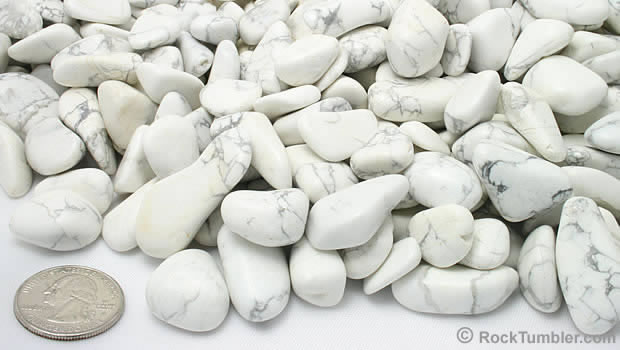

Magnesite Properties | |
| What is Magnesite? | Magnesite is a magnesium carbonate mineral formed by the alteration of limestone or dolomite during hydrothermal metamorphism or contact metamorphism. It is often a snow-white color with gray spider-web-like markings. It is a frequently seen lapidary material used for tumbled stones and beads, less often as cabochons. Lapidarists (people who cut and polish stones) often use magnesite because it is softer than most stones and that makes it very easy to cut. It also takes a bright polish with very little effort. Some is used untreated to display its white color, but it is more often dyed a light bluish color to imitate (or to fake) turquoise. It is also dyed many other colors. Magnesite and howlite are two very different minerals that often have a very similar appearance. As a result they are often confused. We sent one of these stones to the Gemological Institute of America's laboratory and asked them to identify it. They identified it as magnesite. You can see the report here. |
| Color | White, often with gray, brown or black web-like markings. |
| Clarity | Opaque. |
| Uses | These stones are perfect for a variety of jewelry, decorative and craft projects - or simply to admire. |
| Weight | About 75 to 110 stones per pound. |
| Other Information | Some of people who purchase blue "turquoise" are actually purchasing dyed magnesite that has not been disclosed (or sold innocently with an incorrect identification). Turquoise has a Mohs hardness of 5 to 6, and magnesite has a hardness of about 3.5 to 5. The easy way to tell them apart is to make a small amount of powder and apply a drop of warm, dilute HCl. Magnesite will produce a weak effervescence while turquoise will not effervesce. You can also test for the presence of dye by dipping a cotton swab in fingernail polish remover and scrubbing the surface of the stone to see if some of the color transfers to the cotton swab (CAUTION - this is a destructive test). Many dyes used to color magnesite can be dissolved by nail polish remover. |
| Locality | United States |
| Treatments | None known. |

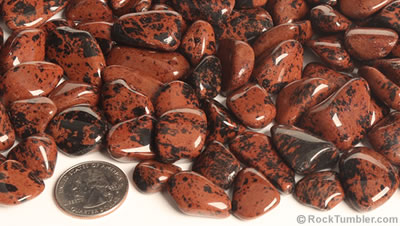
Mahogany Obsidian Properties | |
| What is Mahogany Obsidian? | Mahogany Obsidian is a black glassy igneous rock that contains swirls of brown. Sometimes it is almost entirely brown material with swirls of black obsidian. It is an interesting and rare variety of obsidian. |
| Color | Black with brown, or brown with black swirls. |
| Clarity | Opaque to translucent. |
| Uses | Suitable for a wide variety of decor and craft projects. For jewelry, it is best used in pendants, brooches, and other items that will not be subjected to impact or abrasion. |
| Weight | About 75 to 110 stones per pound. |
| Other Information | Obsidian is a volcanic "glass" because it cools so rapidly that mineral crystals are unable to form. The brown material is probably colored by iron. |
| Locality | USA. |
| Treatments | None known. |
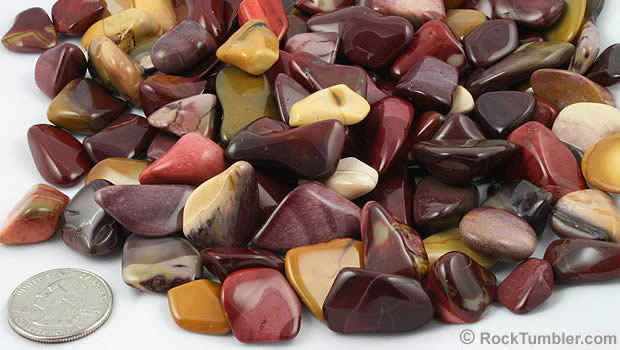

Mookaite Properties | |
| What is Mookaite? | Mookaite is an unusual material. It is mined in Western Australia from the Windalia Radiolarite. A "radiolarite" is sedimentary rock that is made up of radiolarian tests. Radiolarians are tiny organisms that drift in the upper waters of the ocean and produce a thin shell called a "test." When the radiolarians die, their tests sink to the bottom. That is how the Windalia Radiolarite was deposited. After deposition of the tests, groundwater rich in dissolved silica flowed through the sediment and precipitated solid silica in the pore spaces. Where this process completely silicified the rock is where the gemstone material mookaite was formed. |
| Color | Variegated red, maroon, purple, white, cream, yellow, and brown. |
| Clarity | Opaque. |
| Uses | This is an interesting material. Everyone who sees it wants to know more about it. |
| Weight | About 75 to 110 stones per pound. |
| Other Information | Mookaite also has an unusual name. The people who mine it named it after Mooka Creek, a stream that flows over the Windalia Radiolarite near Gascoyne Junction. They added "-ite" to the name of the creek - just like many other mineral and gemstone names have been derived. They named it mookaite. But, if you want to talk like a scientist you could call it "silicified radiolarite." |
| Locality | Western Australia. |
| Treatments | None known. |
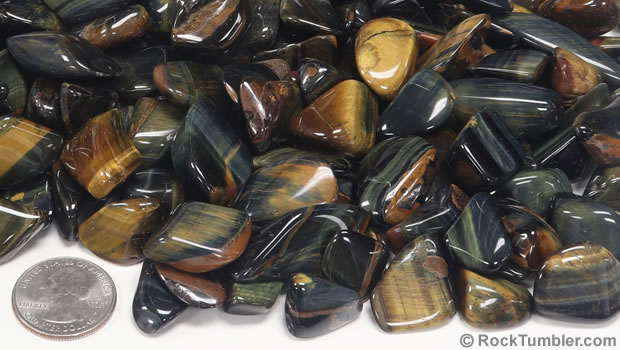

Multi Tiger's-Eye Properties | |
| What is Multi Tiger's-Eye? | Tiger's-Eye is a crocidolite replaced by quartz. The material we offer here is mostly blue tiger's-eye mixed with gold tiger's-eye. The colors can be in blocky patches, or they can be finely intermixed within the same stone. |
| Color | Dark blue with golden to dark brown. |
| Clarity | Translucent to opaque. |
| Uses | Suitable for a wide variety of gemstone, jewelry, decor and craft projects. |
| Weight | About 70 to 100 stones per pound. |
| Other Information | If you like tiger's-eye, you will be fascinated by this multicolor material! |
| Locality | South Africa. |
| Treatments | None known. |
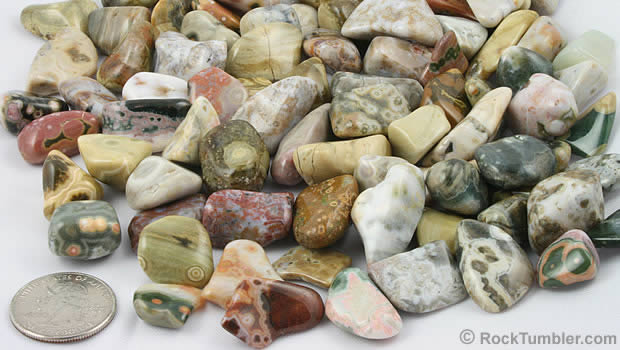

Ocean Jasper Properties | |
| What is Ocean Jasper? | "Ocean Jasper" is a name used for a multicolored gem material produced at two locations in Madagascar. It receives the name from one location on the coast where the deposit is in the intertidal zone. The other location is inland a short distance away. The characteristic appearance of the material is either a round concentric "eye" pattern or a round "poppy flower" pattern. It occurs in a wide variety of colors, but green, red, yellow, brown, white and orange are common. In some specimens the jasper grades into translucent bands of agate or unbanded chalcedony. |
| Color | A wide range of colors that includes green, brown, yellow, red, pink, white. |
| Clarity | Transparent patches, some translucent areas and some opaque areas. |
| Uses | Used in a wide variety of craft, lapidary, jewelry and gemstone projects. Interesting pieces make fantastic pendants. |
| Weight | About 75 to 110 stones per pound. |
| Other Information | Ocean Jasper has been found in a limited area on the coast of Madagascar. The coastline deposit is reportedly close to being mined out, and the inland deposit has a limited amount of material remaining. |
| Locality | Madagascar. |
| Treatments | None known. |
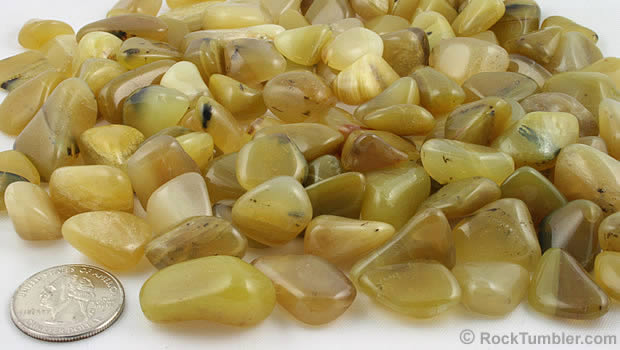

Olive Opal Properties | |
| What is Olive Opal? | This Olive Opal is a common opal from Kenya that obtains its name from its yellowish green to greenish brown "olive" colors. |
| Color | Light yellowish green with thin seams and patches of black mossy material. |
| Clarity | Translucent. |
| Uses | Olive opal is great for a variety of gemstone, craft, jewelry and decorative projects. An unusual and seldom-seen material. |
| Weight | About 75 to 110 stones per pound. |
| Other Information | Has a translucent diaphaneity with a resinous character. |
| Locality | Kenya. |
| Treatments | None known. |
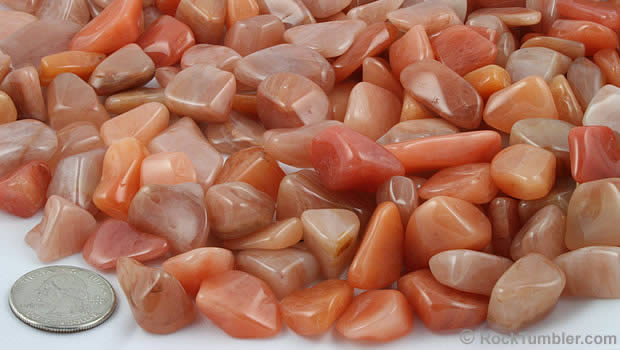

Orange Quartz Properties | |
| What is Orange Quartz? | Quartz is a mineral that occurs in a wide range of colors. It is clear and colorless when it is pure, but a small amount of impurity can give it a light tint of color. Larger amounts will deepen the color and change the appearance from transparent to translucent. This orange quartz contains impurities that give it an orange color. The color ranges from a pale orange to a rich reddish orange, to a brownish orange. |
| Color | A wide range of orange colors, from light orange to bright orange to brownish orange. |
| Clarity | Translucent to almost opaque. |
| Uses | Used in a wide variety of craft, lapidary, jewelry and gemstone projects. |
| Weight | About 75 to 110 stones per pound. |
| Other Information | Many people call this material "peach quartz" because of its color. |
| Locality | India. |
| Treatments | None known. |
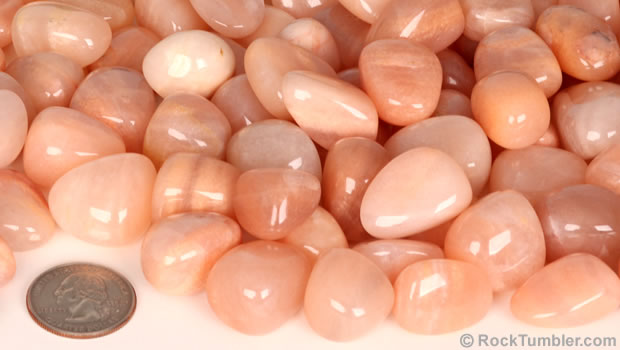

Orange Quartzite Properties | |
| What is Orange Quartzite? | This Orange Quartzite is a metamorphic rock with a wonderful orange color. The stones sold here have a very nice rounded shape and are brightly polished. Orange quartzite is a durable stone that resists scratching and abrasion. These stones have a premium color. We have seen vendors sell this material as "orange moonstone" but we knew that was not correct. We sent one of these stones to the Gemological Institute of America's laboratory, and they identified it as quartzite. You can see the report here. |
| Color | A delicate orange. |
| Clarity | Translucent to opaque. |
| Uses | Suitable for a wide variety of gemstone, jewelry, decor and craft projects. |
| Weight | About 40 to 60 stones per pound. These stones are larger in size than most others on this page. |
| Other Information | The stones in this batch have very pleasing shapes, great color, and a super-bright polish. |
| Locality | Not known. |
| Treatments | None known. |
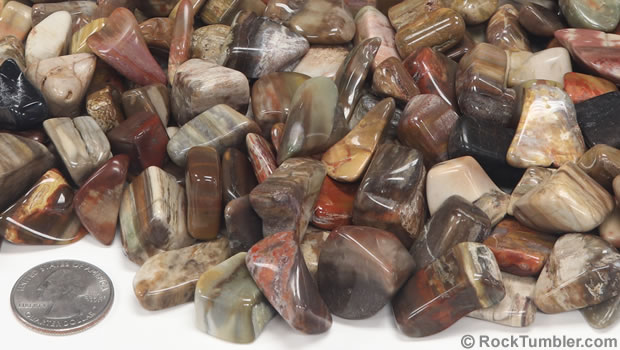

Petrified Wood Properties | |
| What is Petrified Wood? | Petrified wood forms when buried plant debris is replaced by siliceous or carbonate materials delivered by groundwater. This often occurs when a forest is buried under a volcanic ash fall. When polished, these pieces of wood can display interesting patterns such as wood grain, growth rings, and other plant structures. |
| Color | Mostly dark brown to tan and cream colors. A small percentage of pieces have a reddish color, and a few are greenish or black. |
| Clarity | Translucent to opaque. |
| Uses | Suitable for a wide range of gemstone, craft, jewelry and decor projects. |
| Weight | About 75 to 110 stones per pound. |
| Other Information | If you look closely, you might be able to identify wood grain patterns in some of the pieces. However, not all pieces will exhibit identifiable plant structures. |
| Locality | Unknown. |
| Treatments | None known. |
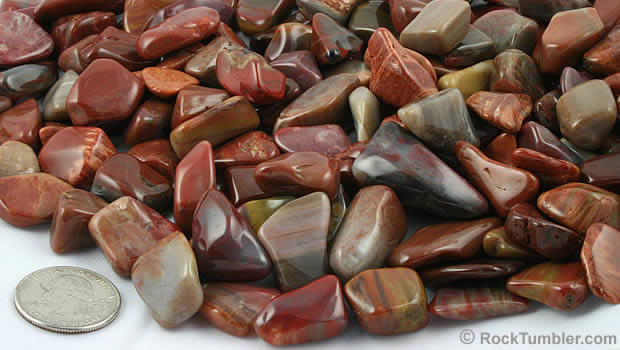

Arizona Petrified Wood Properties | |
| What is Petrified Wood? | For sale are beautifully polished Arizona petrified wood gemstones. Arizona is the most famous locality in the world for petrified wood. It is found there as well-defined logs and branches. However, most of the wood that is found is small pieces scattered across the surface of the land or concentrated in dry washes. It is typically red in color, and small pieces - such as these tumbled stones - are usually too small to exhibit wood grain or structure. |
| Color | Reds, browns, yellow, orange and black. |
| Clarity | Translucent to opaque. |
| Uses | Suitable for a wide range of gemstone, craft, jewelry and decor projects - or simply to admire. |
| Weight | About 75 to 110 stones per pound. |
| Other Information | These stones have the typical coloration of Arizona petrified wood. Reds, browns, yellow, orange and black. |
| Locality | Arizona, USA. |
| Treatments | None known. |
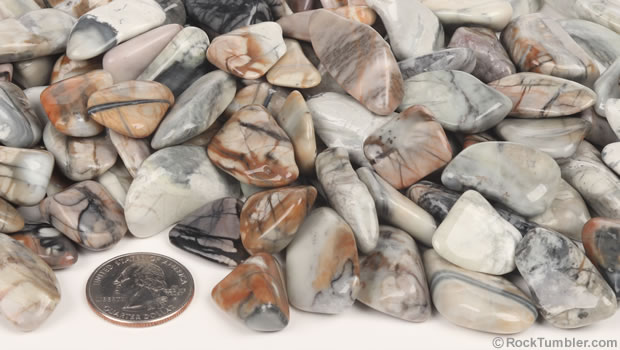

Picasso Stone Properties | |
| What is Picasso Stone? | Picasso Stone is named because its markings and color patterns make some people think of the paintings of artist Pablo Picasso. It is a marble that is only produced in a few locations - one of which is in Utah, USA. |
| Color | Typical colors are browns, grays, black, white, buffs and dark reds. |
| Clarity | Opaque. |
| Uses | We think that Picasso Stone makes a great vase filler. Interesting pieces make wonderful pendants. |
| Weight | About 75 to 110 stones per pound. |
| Other Information | Picasso Stone is rather soft for a gemstone, with a hardness of only 3 to 4 on the Mohs Scale. It scratches easily and is best used in jewelry, craft and decorative projects that will not be subject to impact or abrasion. |
| Locality | Utah, USA. |
| Treatments | None known. |
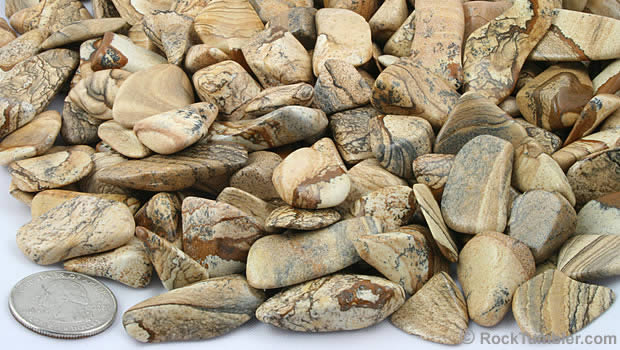

Picture Jasper Properties | |
| What is Picture Jasper? | "Picture jasper" is a nickname for rocks that consist of chalcedony quartz and have a pattern that looks like landscape scenery. They are found in many parts of the world and have been given a wide variety of names. |
| Color | A range of brown, tan, cream and black colors in patterns that form landscape "pictures." |
| Clarity | Opaque. |
| Uses | Best used in jewelry, craft, decor and gemstone projects. |
| Weight | About 75 to 110 stones per pound. |
| Other Information | This picture jasper is a brown, tan and cream colored material with a pattern of brown swirls, lines and curves that makes "pictures" of desert landscapes. A few pieces have black dots and dendrites, most likely from small amounts of manganese in the stone. The polish on this material is a semi-gloss to glossy luster that enhances the desert scenery pattern. |
| Locality | Namibia. |
| Treatments | None known. |
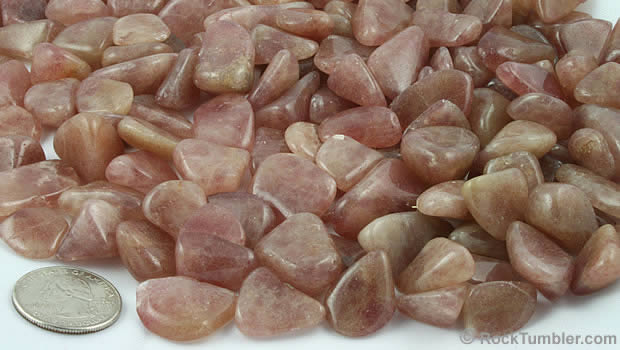

Pink Aventurine Properties | |
| What is Pink Aventurine? | Pink Aventurine is a variety of pink quartz which contains tiny mineral flakes that sparkle when the material is turned in the light. These flakes also produce the pink to lilac to reddish color of the stone. Lepidolite, a lithium-rich mica, is the most likely mineral inclusion that would produce the aventurescence in this pink aventurine. |
| Color | Pinkish purple. |
| Clarity | Translucent. |
| Uses | Suitable for a wide variety of gemstone, jewelry, decor and craft projects. |
| Weight | About 75 to 110 stones per pound. |
| Other Information | Contains abundant inclusions of mica that catch the light to produce a glittering luster known as aventurescence. |
| Locality | Canada. |
| Treatments | None known. |
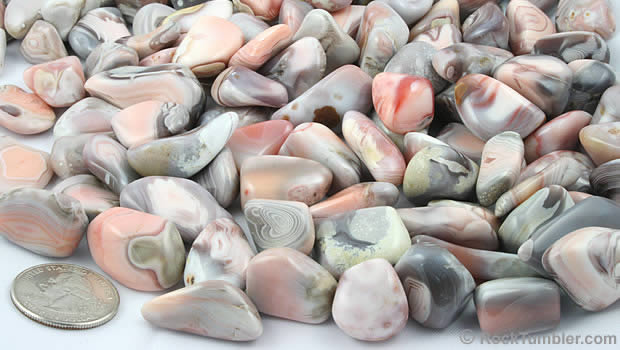

Pink Botswana Agate Properties | |
| What is Pink Botswana Agate? | Pink Botswana is a nodular agate named for its characteristic color and its country of origin. This agate formed as nodules within a basalt host rock. The basalt weathers easily, but the agate nodules are very tough and very resistant. The result is a concentration of nodules in the soil that forms over the basalt and in downslope materials. This allows them to be easily collected for processing into tumbled stones. |
| Color | Pink, grey, white, purplish and honey colors. |
| Clarity | Translucent to opaque. |
| Uses | Suitable for a wide variety of gemstone, jewelry, decor and craft projects. |
| Weight | About 75 to 110 stones per pound. |
| Other Information | The nodules accept a very high polish that reveals their intricate banding, swirls and occasional eyes. The banding is in a variety of colors that includes the dominant pink, gray, purplish, white and occasional zones of honey color. Many of the agates are gray beneath the husk, white and gray banded under the husk, and then transition to pink and white banding towards the center, sometimes with a solid druzy center that might take a nice polish. It is an unusual and beautiful material. |
| Locality | Botswana, of course! |
| Treatments | None known. |
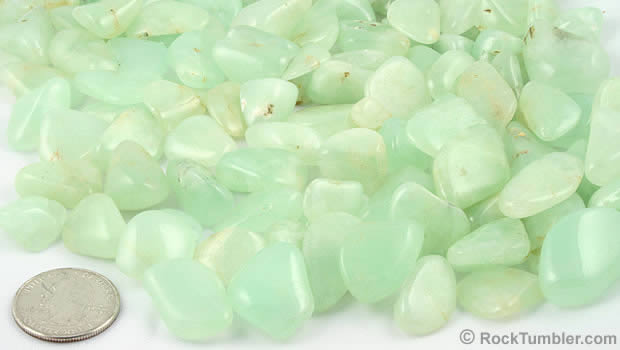

Prehnite Properties | |
| What is Prehnite? | Prehnite is a beautiful mineral that is sometimes used as a gemstone. People who use it as a gemstone material tend to favor specimens in the yellow-green "celery" color range. It is not frequently seen as a gemstone or in jewelry because it is not well-known and is available only in limited supply. It is also rather soft for some jewelry use with a Mohs hardness of about 6. |
| Color | Occurs in a series of colors that range from brown to yellow and from yellow to green. Often a color described as "celery." |
| Clarity | Translucent. |
| Uses | Suitable for a wide variety of gemstone, jewelry, decor and craft projects. |
| Weight | About 75 to 110 stones per pound. |
| Other Information | Some polished prehnite has a wonderful pearly luster. |
| Locality | South Africa. |
| Treatments | None known. |
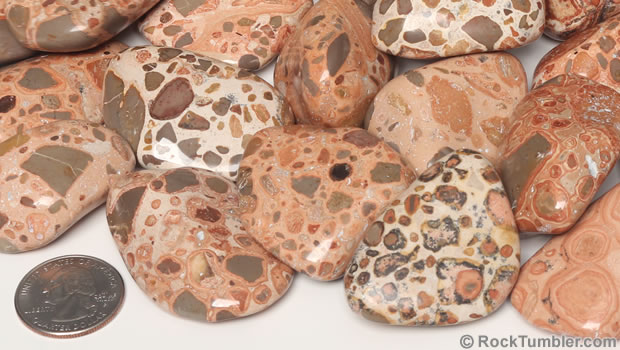

Puddingstone Properties | |
| What is Puddingstone? | Puddingstone is one of the most interesting tumbled stones that we have encountered. The name is perfect because its properties match the definition of "puddingstone" - which has been in use for over 200 years. Here is the definition of puddingstone from an article that I wrote for Geology.com.
"Puddingstone is a nonscientific name for a conglomerate in which subrounded to rounded pebbles occur in a matrix of sharply contrasting color". The name puddingstone originated in Great Britain, perhaps as early as the 17th century, when people picked up local stones and used them to build houses, walls, fences, and foundations. They noticed that some of their stones contained obvious pebbles which reminded them of a "plum pudding" - so they called them "puddingstones" - a name which is still in common use today. What we find especially fascinating about these stones (in addition to their appearance) is their composition. Both the pebbles and the matrix are composed of calcite - a composition that is quite rare. The best geological name for this material is "calcite conglomerate". However, the name "puddingstone" is also a valid name, is widely understood, and is much more intriguing. If you want to learn more about this type of material, I have written an article about puddingstone on Geology.com. |
| Color | Puddingstone occurs in many colors. The stones being sold here have a matrix that ranges from cream to orangy beige. The pebbles occur in a variety of browns and grays. The multicolor appearance of these stones attracts the eye of curious people. |
| Clarity | Opaque. |
| Uses | These stones are larger than most others sold on this page. They make great palm stones, worry stones, or decor stones for your desk, bookshelf, or coffee table. Put one on a bed of smaller stones as an accent in a potted plant or planter. |
| Weight | There are about 11 to 15 stones per pound. |
| Other Information | We do not know of any other sellers of this material as highly polished stones. |
| Locality | Unknown. |
| Treatments | None known. |
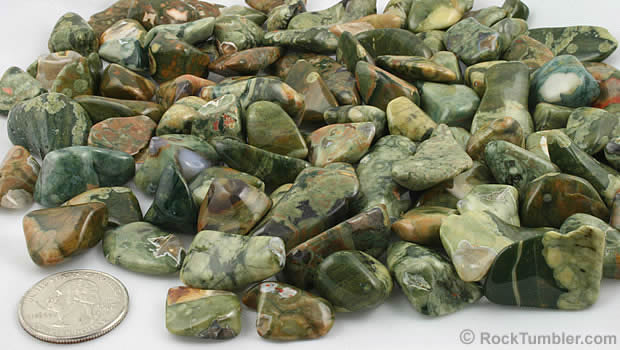

Rainforest Rhyolite Properties | |
| What is Rainforest Rhyolite? | Rainforest Rhyolite, often called "Rainforest Jasper," is a mottled greenish to brownish, heavily patterned material that is thought to have formed by the silicification of rhyolite. It has numerous orbs and poppy-shaped structures. Occasional vug-shaped structures that are sometimes filled with a milky to bluish chalcedony. A few of these vugs are lined with druzy quartz. A material with a very unusual appearance. |
| Color | Light green to bright green to greenish brown. |
| Clarity | Translucent to opaque with tiny vugs that have been filled with a milky to bluish chalcedony. |
| Uses | Rainforest Rhyolite is great for a variety of gemstone, craft, jewelry and decorative projects. |
| Weight | About 75 to 110 stones per pound. |
| Other Information | At first glance, Rainforest Rhyolite looks like Ocean Jasper, and many people confuse them. However, with a little experience of looking at the materials, most people learn how to instantly tell them apart. |
| Locality | Australia. |
| Treatments | None known. |

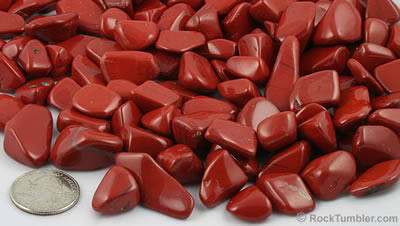
Red Jasper Properties | |
| What is Red Jasper? | Jasper is a semi-translucent to opaque variety of chalcedony that often accepts a very high polish. That is why it is so frequently seen in gemstone and lapidary products. It is also a relatively inexpensive stone, which makes it popular in the marketplace. The material that we have here is brilliant red. |
| Color | Brilliant red. |
| Clarity | Opaque. |
| Uses | Suitable for a wide variety of gemstone, jewelry, decor and craft projects. |
| Weight | About 75 to 110 stones per pound. |
| Other Information | Red is the color that comes to many people's mind when they hear the word "jasper." Jasper is one of the traditional precious stones referred to in the Bible. |
| Locality | South Africa. |
| Treatments | None known. |
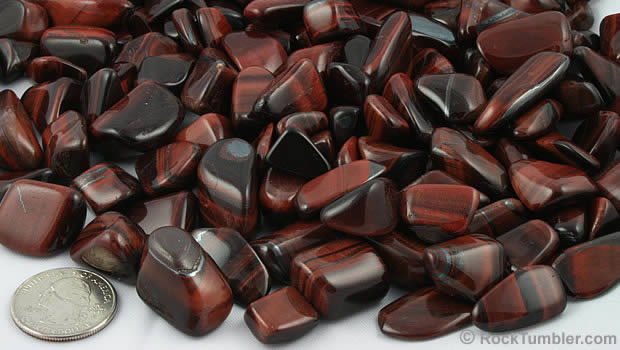

Red Tiger's-Eye Properties | |
| What is Red Tiger's-Eye? | Red Tiger's-Eye is a crocidolite replaced by quartz. Because of the fibrous structure, it produces a chatoyancy when pieces are turned in the light. This chatoyancy produces a line of light across the surface of the stone, which is where the name "Tiger's-Eye" is derived. |
| Color | Deep red to brown-red. |
| Clarity | Opaque. |
| Uses | Makes great keychains. Suitable for a wide variety of gemstone, jewelry, decor and craft projects. |
| Weight | About 75 to 110 stones per pound. |
| Other Information | This material has a very nice reddish brown color. |
| Locality | South Africa. |
| Treatments | Most Red Tiger's-Eye is believed to be Gold Tiger's-Eye that has been exposed to heat. This heating could be natural, as in the case of a lava flow overrunning the deposit or an igneous intrusion occurring nearby. The most likely cause of the heating would be people trying to produce the red color. |
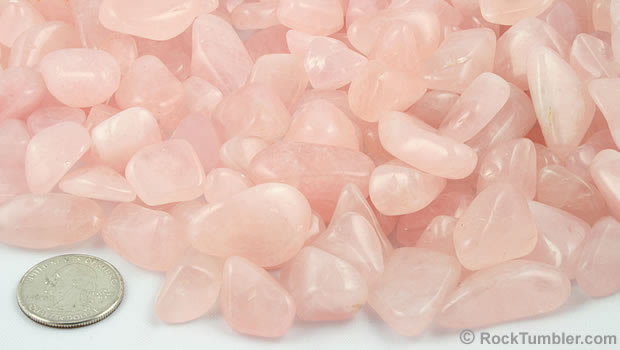

Rose Quartz Properties | |
| What is Rose Quartz? | Rose Quartz is a pink variety of the mineral quartz. Its soft pink color and semi-transparent to translucent diaphaneity make it a very attractive and desirable gemstone. It is one of the most popular tumbled stones that we sell. |
| Color | Pink |
| Clarity | Transparent to translucent. |
| Uses | This material is really nice and makes great pendants. Suitable for a wide variety of gemstone, jewelry, decor and craft projects. |
| Weight | About 75 to 110 stones per pound. |
| Other Information | This material is a customer favorite. |
| Locality | Namibia. |
| Treatments | None known. |
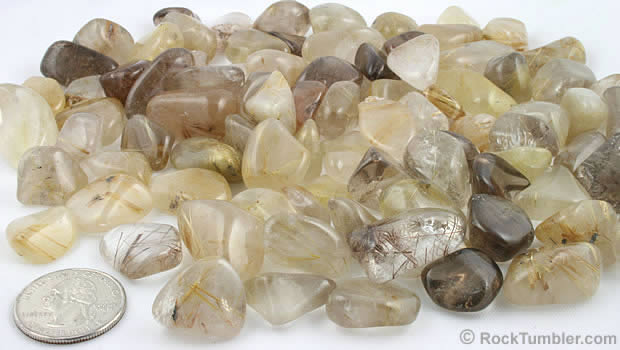

Rutilated Quartz Properties | |
| What is Rutilated Quartz? | Rutilated quartz is a clear to smoky quartz that contains fine needles of rutile. The number of rutile crystals can range from a few isolated needles to enough needles to block the passage of light through the clear quartz. The needles are usually yellow to golden in color. |
| Color | Nearly colorless, to slightly yellow, to smoky quartz with yellow to golden rutile needles. |
| Clarity | Transparent. |
| Uses | Rutilated quartz is great for a variety of gemstone, craft, jewelry and decorative projects. Spectacular pieces are prized. |
| Weight | About 75 to 110 stones per pound. |
| Other Information | Rutile crystals often align with the crystallographic axes of the quartz. |
| Locality | Brazil. |
| Treatments | None known. |
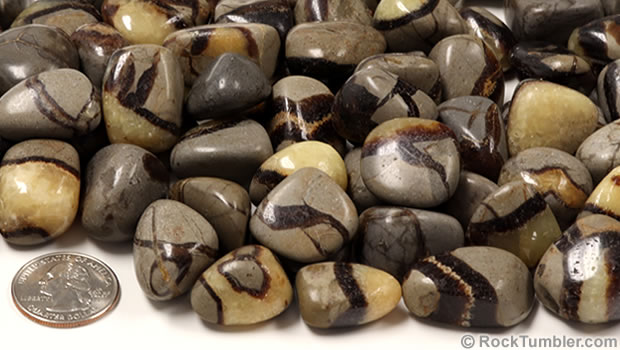

Septarian Stone Properties | |
| What is Septarian Stone? | "Septarian Stones" are broken pieces of septarian nodules that have been tumbled to a pleasing, rounded shape, and then polished. Septarian nodules are spherical concretions that, when broken, exhibit shrinkage cracks that have been infilled with crystals of minerals, such as calcite. In the septarian stones sold here, the yellow material is the calcite crystal infilling of the shrinkage cracks, and the gray material is the clay-rich sediment from which the concretions formed. Learn more about septarian nodules in this Wikipedia article. |
| Color | Gray matrix, crystalline yellow calcite, brown shrinkage crack lining. |
| Clarity | Opaque to translucent. |
| Uses | The calcite portion of septarian stones is easily scratched or broken. These stones are best used for decor and craft projects in which they will not suffer abrasion or impact. Handle with care. |
| Weight | About 35 to 55 stones per pound. These stones have a larger size than most others on this page. |
| Other Information | The stones in this batch have very pleasing shapes and a soft semi-gloss to glossy luster. |
| Locality | Not known. |
| Treatments | None known. |
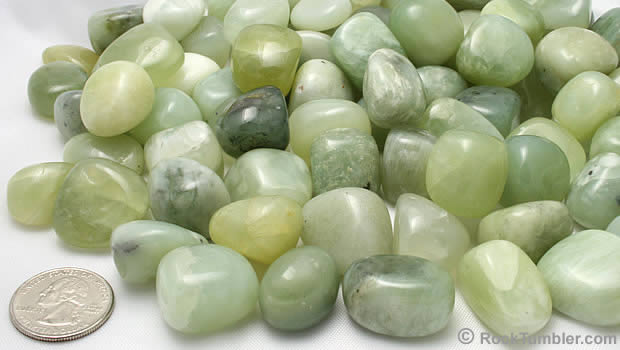

Serpentine Properties | |
| What is Serpentine? | Serpentine is the name given to a large group of minerals that are found in the metamorphic environment of convergent plate boundaries where at least one of the plates was of oceanic lithosphere. |
| Color | Commonly a light green, yellowish green, or dark green material. Often mottled or cross-cut with fracture fillings. |
| Clarity | Translucent, often with a soft waxy luster. |
| Uses | Serpentine is used to make tumbled stones, beads, and cabochons. It is also used to make small sculptures because it is relatively soft, has a uniform grain and is easy to carve. Large amounts of serpentine are used for architectural and ornamental stone in interior and exterior design work. |
| Weight | These are larger pieces than most other stones shown on this page; most are about 7/8" to 1 1/4" across. There are about 40 to 60 stones in a pound. |
| Other Information | The material being sold here has a soft green color and translucence. |
| Locality | Unknown. |
| Treatments | None known. |

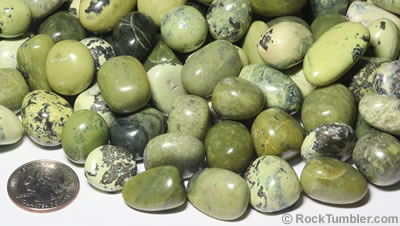
Peruvian Serpentine Properties | |
| What is Peruvian Serpentine? | This unique serpentine is mined in Peru. It ranges in color from a pastel yellowish green, to a pistachio green, to an olive green. But, what makes it unique is the variety of metallic mineral inclusions that are found in many of the stones.
-- Some pieces have included crystals of pyrite - you can recognize these by their brassy gold luster, often with cubic outlines. -- Some pieces have inclusions of magnetite - you can recognize magnetite by its submetallic gray luster and the fact that it is strongly magnetic. Sometimes you can pick up the entire tumbled stone by touching a magnet to the magnetite inclusions. -- Finally, there are inclusions of chromite. These have a black, submetallic luster and are sometimes weakly magnetic. Some stones have none of the above inclusions, some have just one type, some have two, and a rare piece will contain all three. These tumbled stones are geologically interesting because of the inclusions; we think you will enjoy them. |
| Color | Pastel yellowish green, to pistachio green, to a deep olive green - often with exposed inclusions of gold pyrite or black chromite / magnetite. |
| Clarity | Translucent to opaque. |
| Uses | Serpentine is a soft mineral and is easily scratched. That will limit its use in jewelry - and you should also be careful not to handle it roughly. |
| Weight | About 40 to 65 stones per pound. These stones are plump and chunky. When you have one in your hand you know that you have something. |
| Other Information | We first saw these tumbled stones in an Illinois gift shop. The incredible inclusions got our attention, and we were very happy to find a commercial source. |
| Locality | Peru. |
| Treatments | We believe that the stones we are selling have their natural color - meaning they are untreated. |

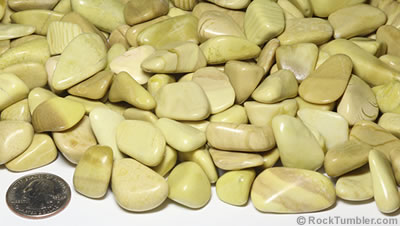
Yellow Serpentine Properties | |
| What is Yellow Serpentine? | Serpentine is the name of a large group of minerals that form in the metamorphic environment of convergent plate boundaries, where at least one of the plates is of oceanic lithosphere. Serpentine is usually light green, yellowish green, or dark green. It is often mottled or cross-cut with fracture fillings. |
| Color | The serpentine we are selling here is yellowish green to greenish yellow with a waxy luster. |
| Clarity | Opaque. |
| Uses | Suitable for a wide variety of gemstone, jewelry, decor and craft projects. |
| Weight | About 60 to 85 stones per pound. |
| Other Information | Some pieces are distinctly banded, while others have a uniform color. |
| Locality | Unknown. |
| Treatments | None known. |
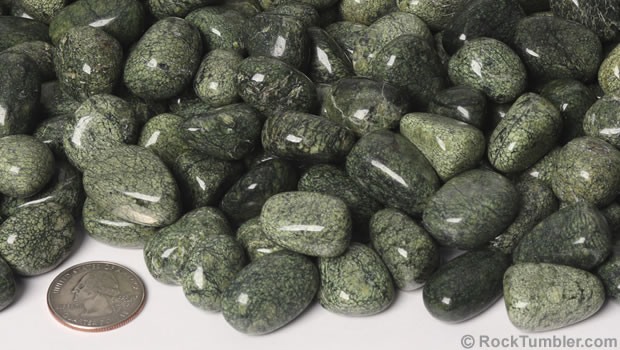

Snakeskin Properties | |
| What is Snakeskin? | "Snakeskin" is a new arrival to the tumbled stone marketplace of the United States. We first saw it in 2020, and it is one of the most interesting lapidary materials that we have seen in a long time. The polished surfaces of these stones have a green and black scaly appearance that reminds you of the skin of a snake. No kidding!
Many people are calling this stone "snakeskin jasper". We don't agree with that name because the hardness of this material is only four on the Mohs scale, while genuine jasper has a hardness of seven. We think the properties of this material are consistent with the properties of serpentine - but before we start calling it anything other than "snakeskin" we are sending specimens to GIA for lab testing. As soon as we have a species/variety name we are confident with, we will update the information here. |
| Color | Yellowish green to dark green on black. |
| Clarity | Translucent to opaque. |
| Uses | Snakeskin is soft and easily scratched, and that will limit its use in jewelry. You should also be careful not to handle it roughly. The best thing about these stones is their appearance. You will be amazed at how much they look like snakes! Some stones are nicely egg-shaped, and you could probably tell gullible people that they are snake eggs and they would believe it... just kidding! |
| Weight | About 45 to 65 stones per pound. |
| Other Information | We are always watching for new and interesting tumbled stones. The first time we saw snakeskin being offered for sale was in 2020. We think that the stone is going to be wildly popular. |
| Locality | Unknown. |
| Treatments | We believe that the stones we are selling have their natural color - meaning they are untreated. |
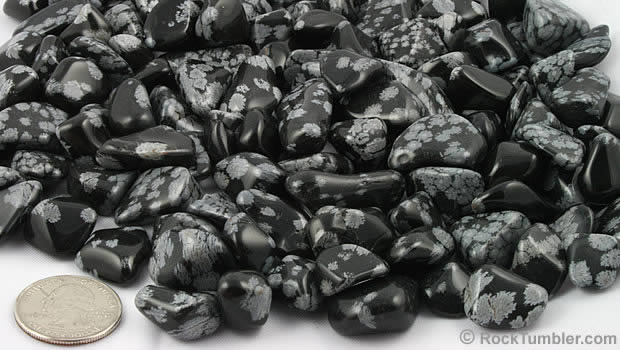

Snowflake Obsidian Properties | |
| What is Snowflake Obsidian? | Snowflake Obsidian is a black glassy igneous rock that is splashed with white to gray snowflake-shaped spots of various sizes. It is a popular gemstone material that is frequently seen in craft, decorative and jewelry projects. |
| Color | Black with gray to white snowflakes. |
| Clarity | Opaque to translucent. |
| Uses | Suitable for a wide variety of decor and craft projects. For jewelry, it is best used in pendants, brooches, and other items that will not be subjected to impact or abrasion. |
| Weight | About 75 to 110 stones per pound. |
| Other Information | Snowflake Obsidian is a volcanic "glass" because it cools so rapidly that mineral crystals are unable to form. The white "snowflakes" are radially-clustered crystals of the mineral cristobalite, a high-temperature polymorph of quartz. They form as the glass recrystallizes. |
| Locality | USA. |
| Treatments | None known. |
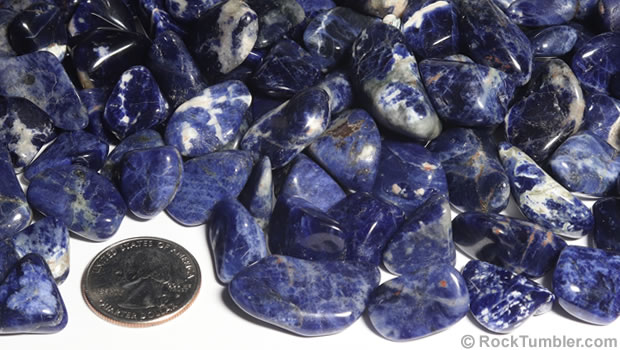

Sodalite Properties | |
| What is Sodalite? | Blue minerals are a small minority in nature. Sodalite is one of a few minerals best known for its deep blue color. Although sodalite is usually blue, it can also be gray, white, yellow, green or pink. It is frequently cut by white veins of calcite. |
| Color | Shades of blue from medium hues to midnight blue, intermixed with white and yellowish gray. |
| Clarity | Translucent to opaque. |
| Uses | Makes beautiful pendants. Suitable for a wide variety of gemstone, jewelry, decor and craft projects. |
| Weight | About 75 to 110 stones per pound. |
| Other Information | The rich blue color of sodalite attracts a lot of attention and helps the material sell easily. It is also a rare mineral to find in quantities that are worth producing, yet the rarity is usually not reflected by a high price. |
| Locality | Produced at various locations. |
| Treatments | None known. |


Sunset Sodalite Properties | |
| What is Sunset Sodalite? | "Sunset Sodalite" is a marketing name for a rock that contains patches of deep blue sodalite, patches of orange sodalite, and a mix of other white and black minerals. Many people call this material "sunset sodalite" or "sunrise sodalite" because of its mix of blue and orange color. Sodalite is best known for its deep blue color. However, sodalite can occur in a wide range of other colors that include white, gray, green, pink, brown, and orange. |
| Color | Deep blue and pinkish orange sodalite with streaks of other white minerals. |
| Clarity | Translucent to opaque. |
| Uses | Makes beautiful pendants. Suitable for a wide variety of gemstone, jewelry, decor and craft projects. |
| Weight | About 75 to 110 stones per pound. |
| Other Information | The beautiful mix of orange and blue color in these stones attracts attention because most people have never seen this material. |
| Locality | Produced at various locations. |
| Treatments | None known. |
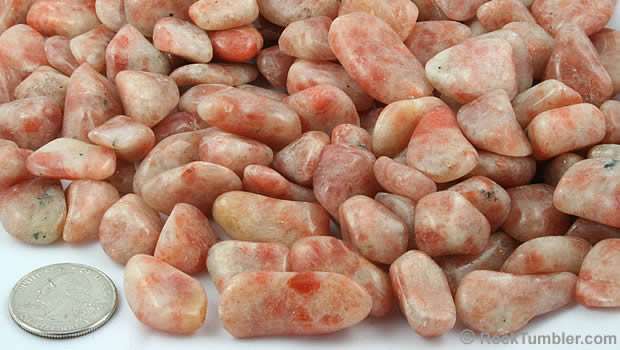

Sunstone Properties | |
| What is Sunstone? | Sunstone is the name given to specimens of feldspar that contain plate-shaped inclusions in parallel orientations. When light enters the stone, it reflects from these inclusions to produce a flash of light. These stones contain inclusions thought to be copper or hematite that produce a reddish flash. |
| Color | White feldspar mottled with orange areas caused by included mineral grains. |
| Clarity | Translucent. |
| Uses | Suitable for a wide variety of gemstone, jewelry, decor and craft projects. |
| Weight | About 75 to 110 stones per pound. |
| Other Information | The flash of light produced by the reflecting mineral grains is known as "aventurescence." |
| Locality | India. |
| Treatments | None known. |
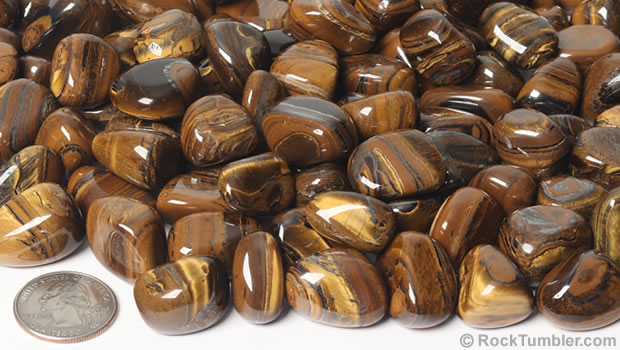

Tiger Iron Properties | |
| What is Tiger Iron? | Tiger Iron is a trade name for a rock that is a banded mixture of tiger's-eye, red to brown jasper, and iron ore minerals such as hematite or magnetite. Tiger iron is also known as "tiger's-eye matrix". Some Tiger Iron contains enough magnetite and magnetic hematite that it can be picked up with a common magnet. Most of the stones being sold here have some magnetic attraction. A few contain enough magnetic minerals that they can be lifted with a common magnet. |
| Color | The stones that we are selling have an overall "brown" appearance. They contain layers and patches of gold tiger's eye, bands and patches of a caramel brown jasper, and thin metallic layers of silver-colored hematite or metallic gray magnetite. |
| Clarity | Opaque. |
| Uses | Suitable for a wide variety of gemstone, jewelry, decor and craft projects. |
| Weight | These stones have a pleasingly heavy feel. They weigh about twice as much as most other stones of similar size. About 40 to 55 stones per pound. |
| Other Information | When you receive these stones, take a few minutes to look at them closely in sunlight or under a bright lamp. We are always impressed by the flashes of gold tiger's-eye, bright reflections from thin bands of silver hematite, and jasper polished to a super-bright luster. |
| Locality | South Africa. |
| Treatments | None known. |
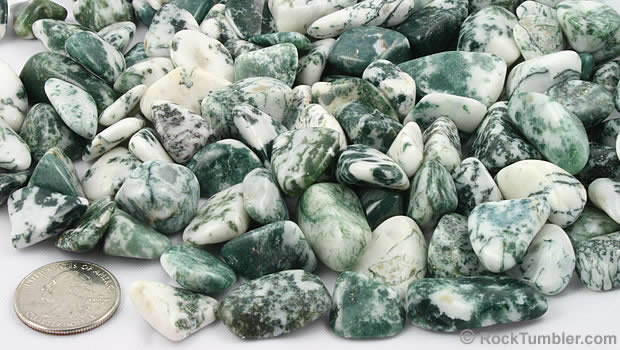

Tree Agate Properties | |
| What is Tree Agate? | Tree Agate is a white, semi-translucent to opaque chalcedony that contains deep green mossy or dendritic inclusions. These inclusions are seen where they intersect the surface of the stone and make a green tree-like pattern - thus the name "green tree" agate. |
| Color | Agate with a white base color with inclusions of dendritic green moss showing through. |
| Clarity | Translucent to opaque. |
| Uses | Suitable for a wide variety of gemstone, jewelry, decor and craft projects. |
| Weight | About 75 to 110 stones per pound. |
| Other Information | Green Tree Agate is very similar to Green Moss Agate, although their appearance might not suggest that. They are often mined from the same deposit. Green Tree Agate is dendrites in an opaque chalcedony, while Green Moss Agate is dendrites in a transparent to translucent chalcedony. In the Green Moss you can look "into" the stone and see the moss in three dimensions. In the Green Tree Agate you only see the moss where it intersects the surface of the stone. |
| Locality | Botswana. |
| Treatments | None known. |
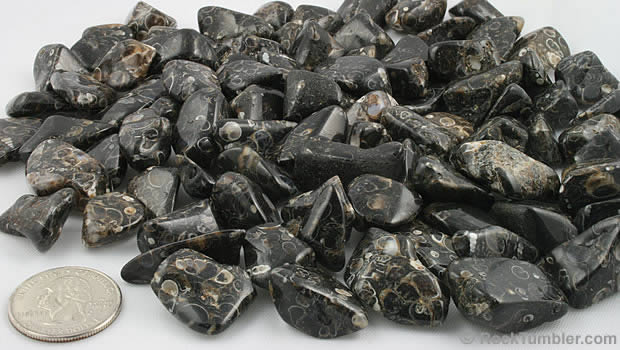

Turritella Agate Properties | |
| What is Turritella Agate? | Turritella Agate is the popular name used for a brown, translucent, fossiliferous agate found in the Green River Formation of Wyoming. It is very easy to recognize because it contains large fossil snails that stand out in a white-to-tan color that contrasts with the dark brown agate. The name "Turritella" was given because the person who first named the material thought that the fossils were of the Turritella genus. That turned out to be incorrect. The fossils are really Elimia tenera, a member of the Pleuroteridae family... but the Turritella name has become entrenched into the vocabulary of rockhounds everywhere. |
| Color | A light brown to dark brown basecolor agate cementing fossil gastropod (marine snail) shells. |
| Clarity | Translucent to opaque. |
| Uses | Turritella is great for a variety of gemstone, craft, jewelry and decorative projects. Specimens that exhibit a nice fossil shell are especially desired. |
| Weight | About 75 to 110 stones per pound. |
| Other Information | Turritella is most likely the best-known fossil from the Green River Formation. And, most people don't know this... but if you look at it with a good magnifying glass or a microscope, you will see a tremendous number of fossils that are too small to see with your unaided eye. |
| Locality | United States. |
| Treatments | None known. |
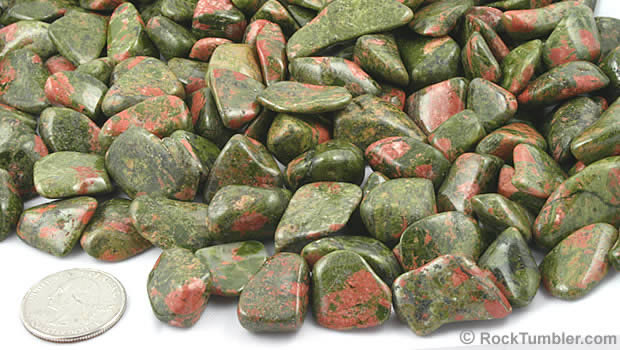

Unakite Properties | |
| What is Unakite? | Unakite is an igneous rock composed mainly of pink orthoclase feldspar, yellow-green epidote, quartz and minor amounts of other minerals. It is a "granitic rock" of unusual color, composition and appearance. |
| Color | Pink orthoclase blended with yellow-green epidote. |
| Clarity | Opaque. |
| Uses | Suitable for a wide variety of gemstone, jewelry, decor and craft projects. |
| Weight | About 75 to 110 stones per pound. |
| Other Information | Unakite is named for the Unaka Mountains of eastern Tennessee. Much of the commercial Unakite sold today is mined in Zimbabwe and South Africa. It is also found at other locations around the world. |
| Locality | South Africa. |
| Treatments | None known. |
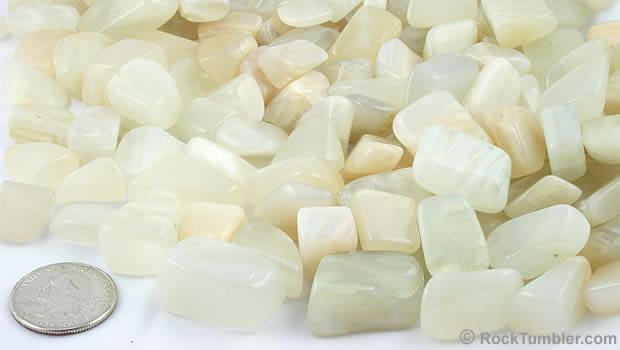

White Moonstone Properties | |
| What is White Moonstone? | Moonstone is a gemstone of the feldspar mineral family. It is a material that consists of finely interlayered orthoclase and albite. Light entering the stone is scattered as it passes through alternating layers of the orthoclase and albite, and that scattered light produces a glow known as "adularescence." This glow seems to float just under the surface of the stone. The glow reminds some people of the glow of a full moon - this is how the name "moonstone" originated. |
| Color | A range of colors between white, light gray, yellowish, sometimes with a touch of pink. |
| Clarity | Translucent. |
| Uses | Nice pieces make great pendants. A beautiful vase filler. Attractive as ground cover in potted plants. Great in decor, craft and jewelry projects of all kinds. |
| Weight | About 75 to 110 stones per pound. |
| Other Information | Feldspar minerals cleave in two directions at right angles. Because of that, tumbled moonstone usually has a "blocky" shape. The "glow" can be seen on two of the block's "faces." If you see the glow, flip the stone over and a similar glow should be seen on the opposite side of the stone. |
| Locality | India. |
| Treatments | None known. |
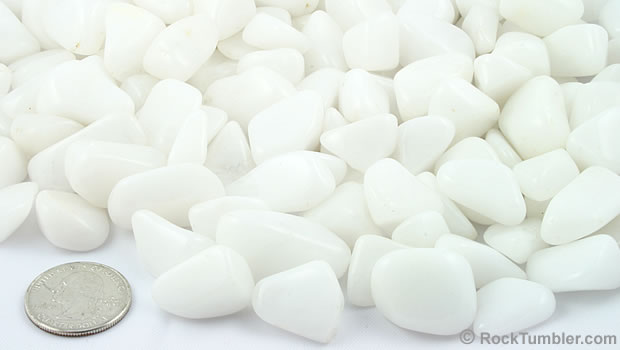

White Quartz Properties | |
| What is White Quartz? | This White Quartz is a variety of quartz that is brilliant white in color. This is rare because quartz usually contains inclusions or impurities that alter its color. This quartz is so white that many people call it "snow quartz." Geologists report that the milky white color of some quartz is caused by gas-filled inclusions within the stone. |
| Color | Exceptionally white! |
| Clarity | Translucent. |
| Uses | Suitable for a wide variety of gemstone, jewelry, decor and craft projects. |
| Weight | About 75 to 110 stones per pound. |
| Other Information | Quartz is the most abundant mineral species in Earth's crust, and white quartz is almost as ubiquitous in its occurrence. It is surprising that such a common material - that polishes exceptionally well - is rarely seen as a tumbled stone. |
| Locality | From various locations. |
| Treatments | None known. |
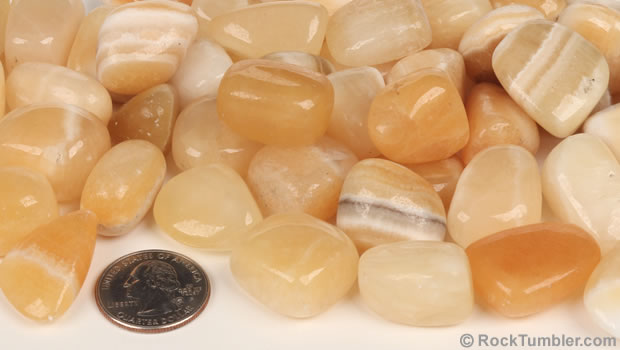

Yellow Calcite Properties | |
| What is Yellow Calcite? | Calcite is a very common mineral with a chemical composition of CaCO3. It has many uses in the chemical, agricultural, and pharmaceutical industries. It is not often seen as a tumbled stone because it is very soft and difficult to polish to a bright luster. In our opinion, these stones were polished by a "master". These beautiful stones have a wonderful range of pale yellow, to rich yellow, to orangy yellow color. Some of them display color banding, and some have a beautiful translucence. |
| Color | These beautiful stones have a wonderful pale yellow, to rich yellow, to orangy yellow color. |
| Clarity | Translucent to opaque. |
| Uses | Calcite is very soft. It is not suitable for jewelry use because it scratches and fractures easily. These beautiful stones are best used in decor and craft projects in which they will be admired rather than worn or handled. Handle with care. |
| Weight | About 30 to 50 stones per pound. These are chunky stones, larger than most of the other stones sold on this page. |
| Other Information | The stones in this batch have a rounded, chunky shape. |
| Locality | Not known. |
| Treatments | None known. |
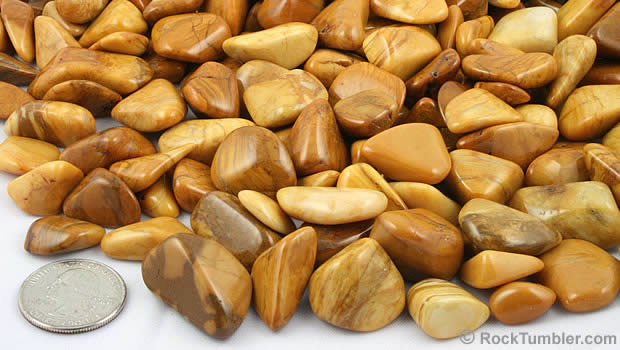

Yellow Jasper Properties | |
| What is Yellow Jasper? | Yellow Jasper is an attractive material that ranges from a cream yellow to a rich yellow-brown. |
| Color | Swirls and bands of cream yellow to rich yellow-brown. |
| Clarity | Translucent to opaque. |
| Uses | Suitable for a wide variety of gemstone, jewelry, decor and craft projects. |
| Weight | About 75 to 110 stones per pound. |
| Other Information | Yellow-brown is a very common color of jasper that is found at many locations around the world. |
| Locality | South Africa. |
| Treatments | None known. |
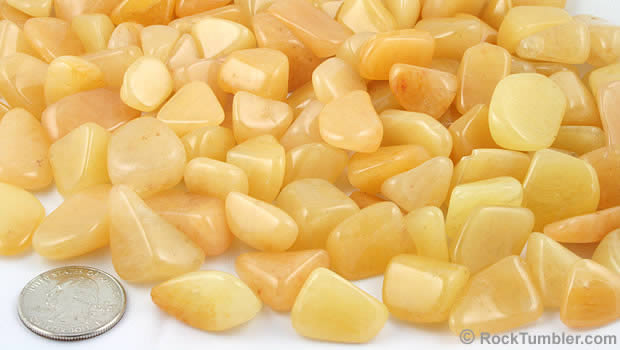

Yellow Quartz Properties | |
| What is Yellow Quartz? | Quartz is a mineral that is clear and colorless when pure, but trace amounts of impurities in its crystal structure or a scatter of mineral inclusions within the crystal can modify its color. This yellow quartz is a gemmy translucent material. If you look very closely with a hand lens, some pieces appear to have a thick yellow moss pulled through a transparent quartz. Without looking closely you would never notice. |
| Color | Yellow to yellow-peach. |
| Clarity | Translucent. |
| Uses | Suitable for a wide variety of gemstone, jewelry, decor and craft projects. |
| Weight | About 75 to 110 stones per pound. |
| Other Information | This yellow quartz is different from the yellow transparent quartz known as "citrine." Although citrine is more widely known, we think that the translucence and bright yellow color of this material rivals citrine in beauty. |
| Locality | India. |
| Treatments | None known. |
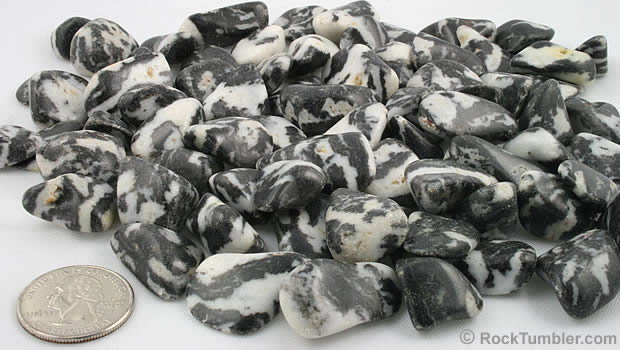

Zebra Marble Properties | |
| What is Zebra Marble? | Zebra Marble is a white and black material that might remind you of the coloration of a zebra. |
| Color | Bright white and black in sharp contact and contrast. |
| Clarity | Translucent to opaque. |
| Uses | Zebra Marble is great for a variety of gemstone, craft, jewelry and decorative projects. |
| Weight | About 70 to 100 stones per pound. |
| Other Information | Zebra Marble is a true marble - it will effervesce weakly in contact with cold hydrochloric acid. However, it is a bit harder than 3 on the Mohs Scale. It is most likely a dolomitic marble. |
| Locality | United States. |
| Treatments | None known. |

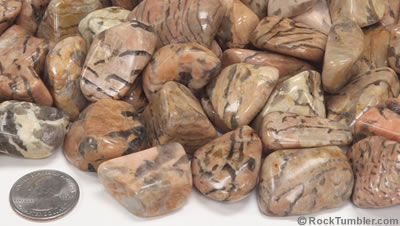
Zebradorite Properties | |
| What is Zebradorite? | "Zebradorite" is a marketing name for an igneous rock that forms when magma slowly cools and crystallizes deep below Earth's surface. The slow cooling rate allows large crystals of feldspar and quartz to grow. The quartz and the feldspars crystallize at about the same temperature, and as a result they are often intergrown with one another in interesting patterns. These patterns often resemble runic or cuneiform writing, and that is what makes this stone appealing to many people.
The stones being sold here exhibit gray quartz crystals in a matrix of off-white to pinkish feldspar. The geological name for this rock is "graphic granite" after the writing-like shape of some of the quartz crystals. The word "graphic" in the name of this rock is after the Greek word "graphos" - which means "to write". Common names used for this rock include "Hebrew stone" and "runite". |
| Color | A matrix of off-white to pinkish feldspar with intergrowths of gray quartz. |
| Clarity | Translucent to opaque. |
| Uses | Graphic granite is mainly used in prestige architecture as stair treads, floor tiles, wall panels, planters, etc. It is also found in many homes as countertops, window sills, and ornamental stone. Zebradorite is a popular and attractive stone for making cabochons, large beads, and other jewelry items. It is also used for small carvings, tumbled stones, lapidary crafts, and decorative projects. |
| Weight | About 20 to 40 stones per pound. |
| Other Information | If you closely examine tumbled stones made from zebradorite, you might notice that some stones have quartz crystals that can be visible at more than one location on the surface of the stone. Many of the quartz crystals are actually long "stringers" that travel through the stone. |
| Locality | We believe that the stones being sold here were mined in Madagascar. Graphic granite is an igneous rock found at many locations throughout the world. |
| Treatments | None known. |
